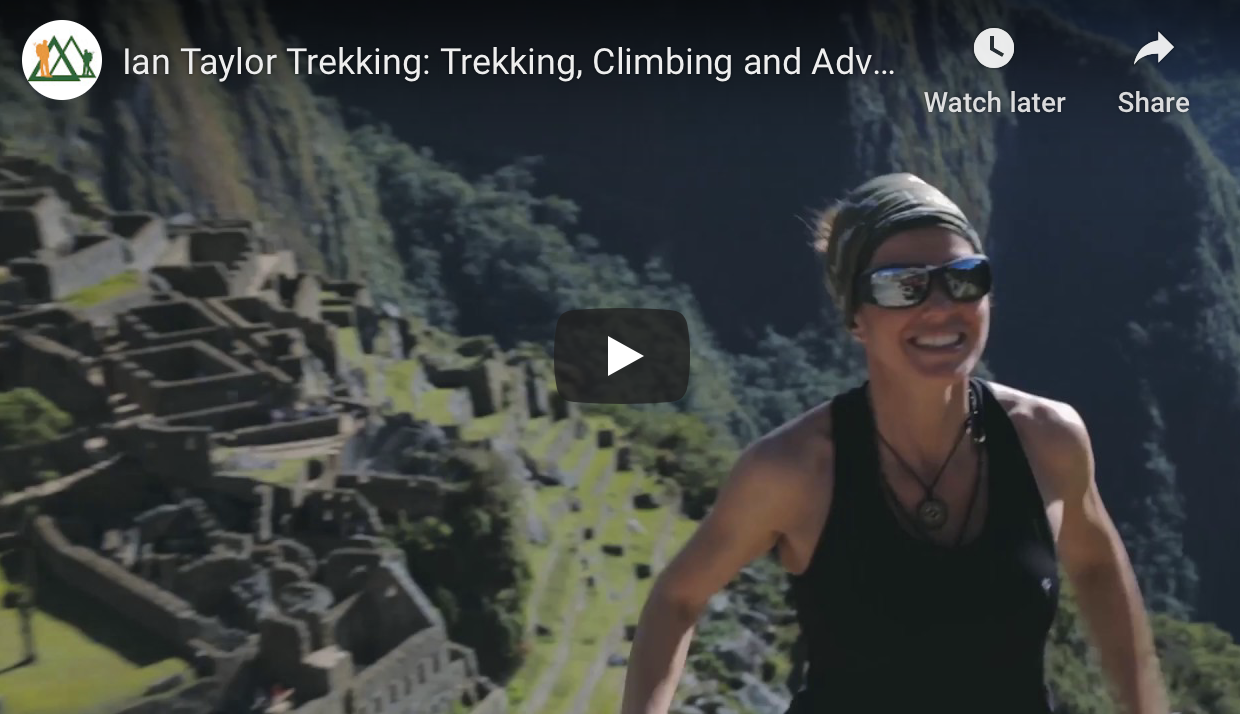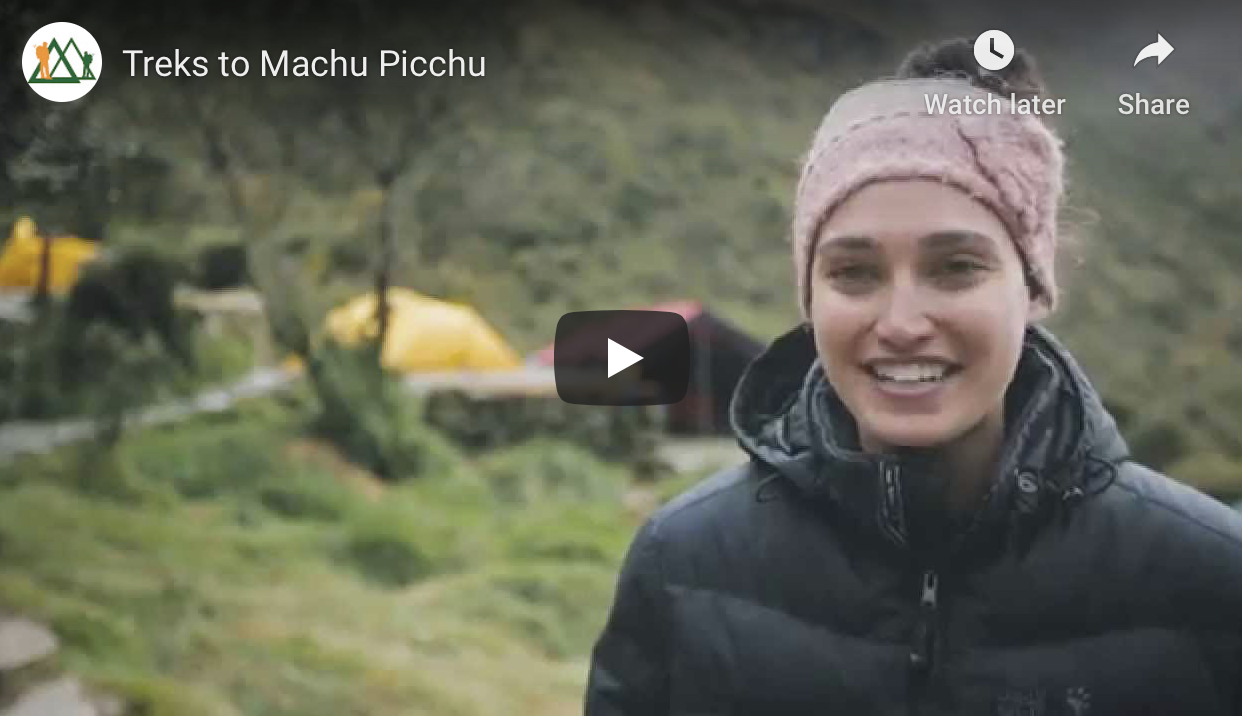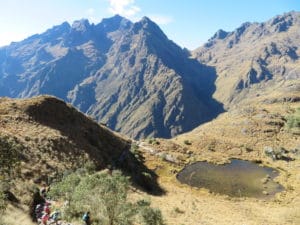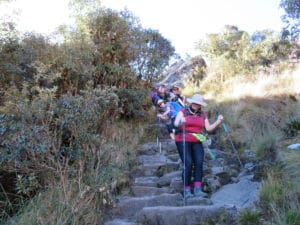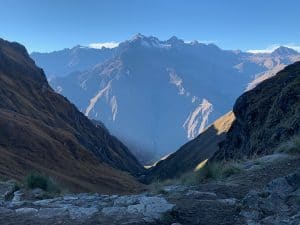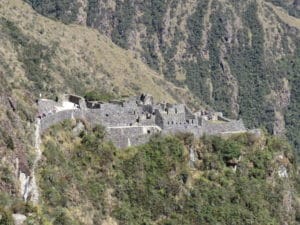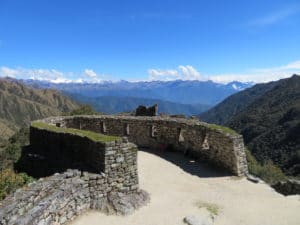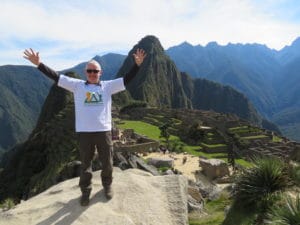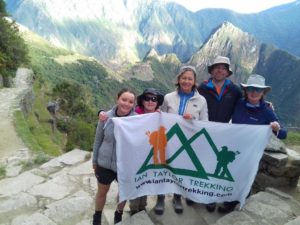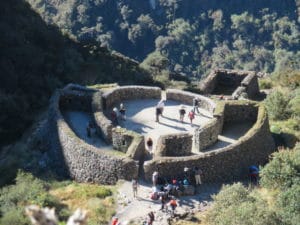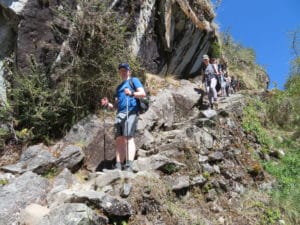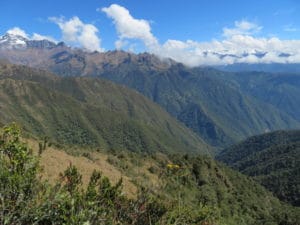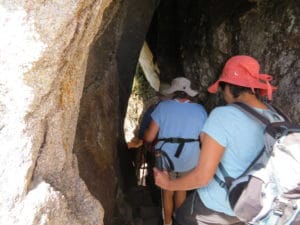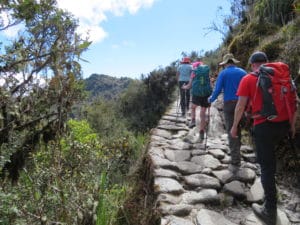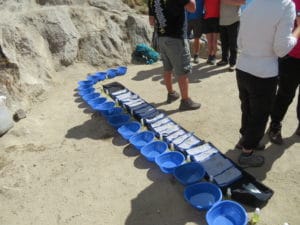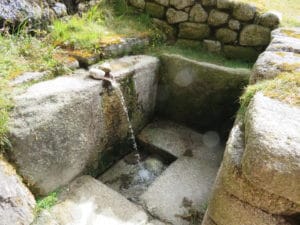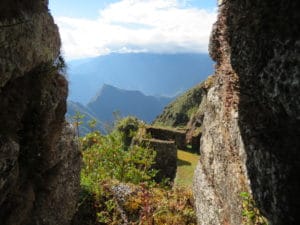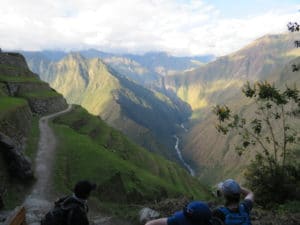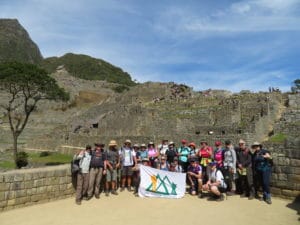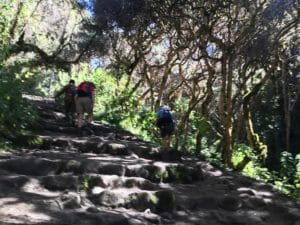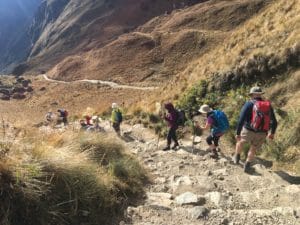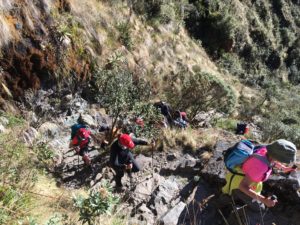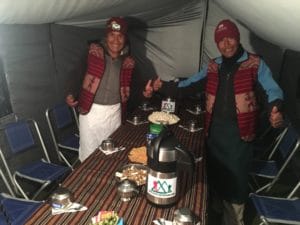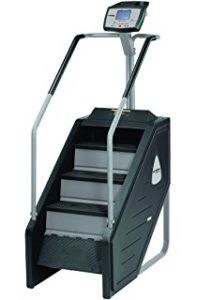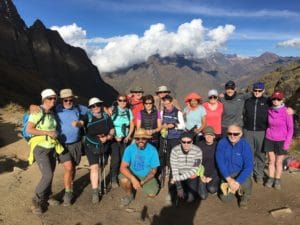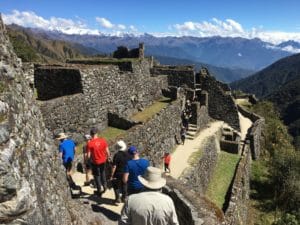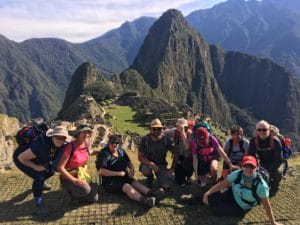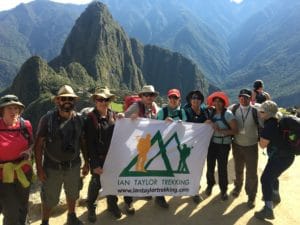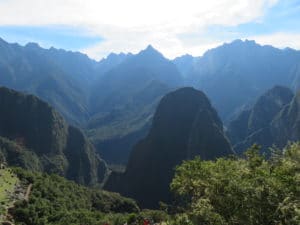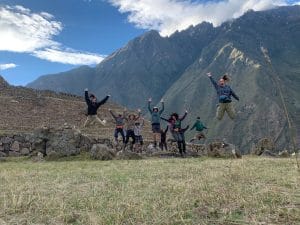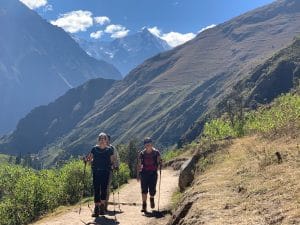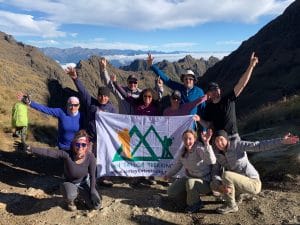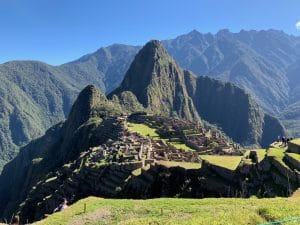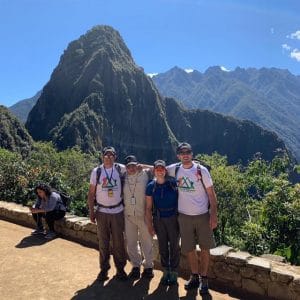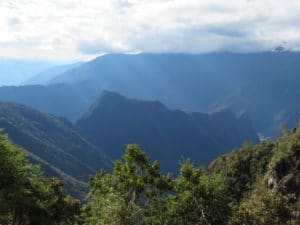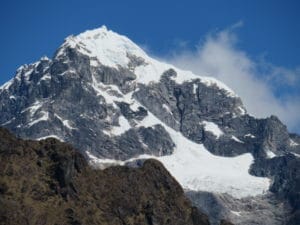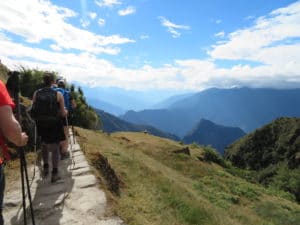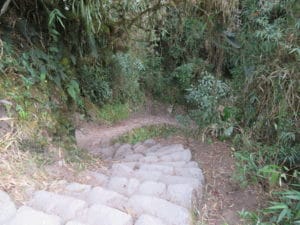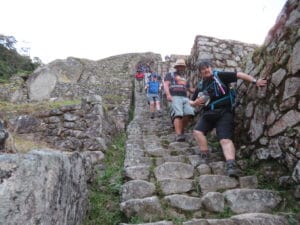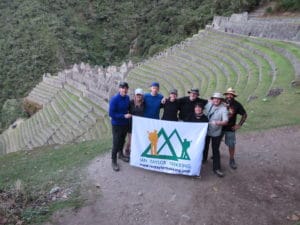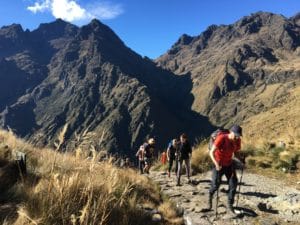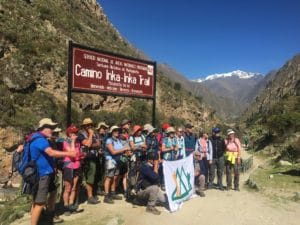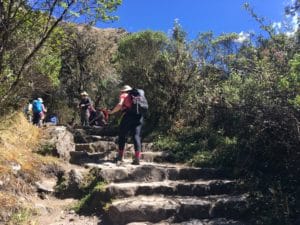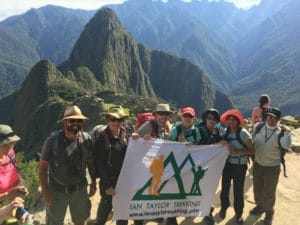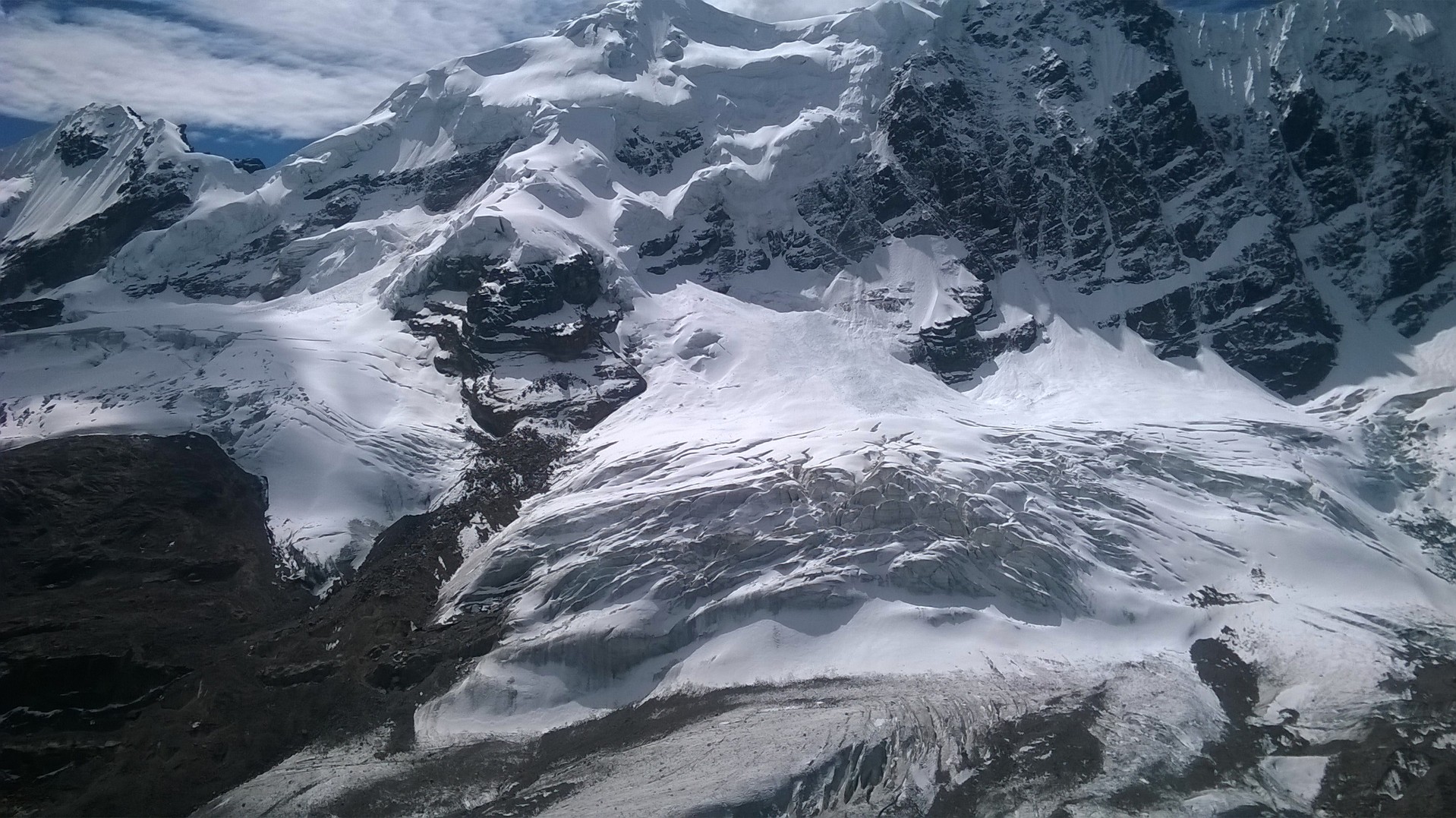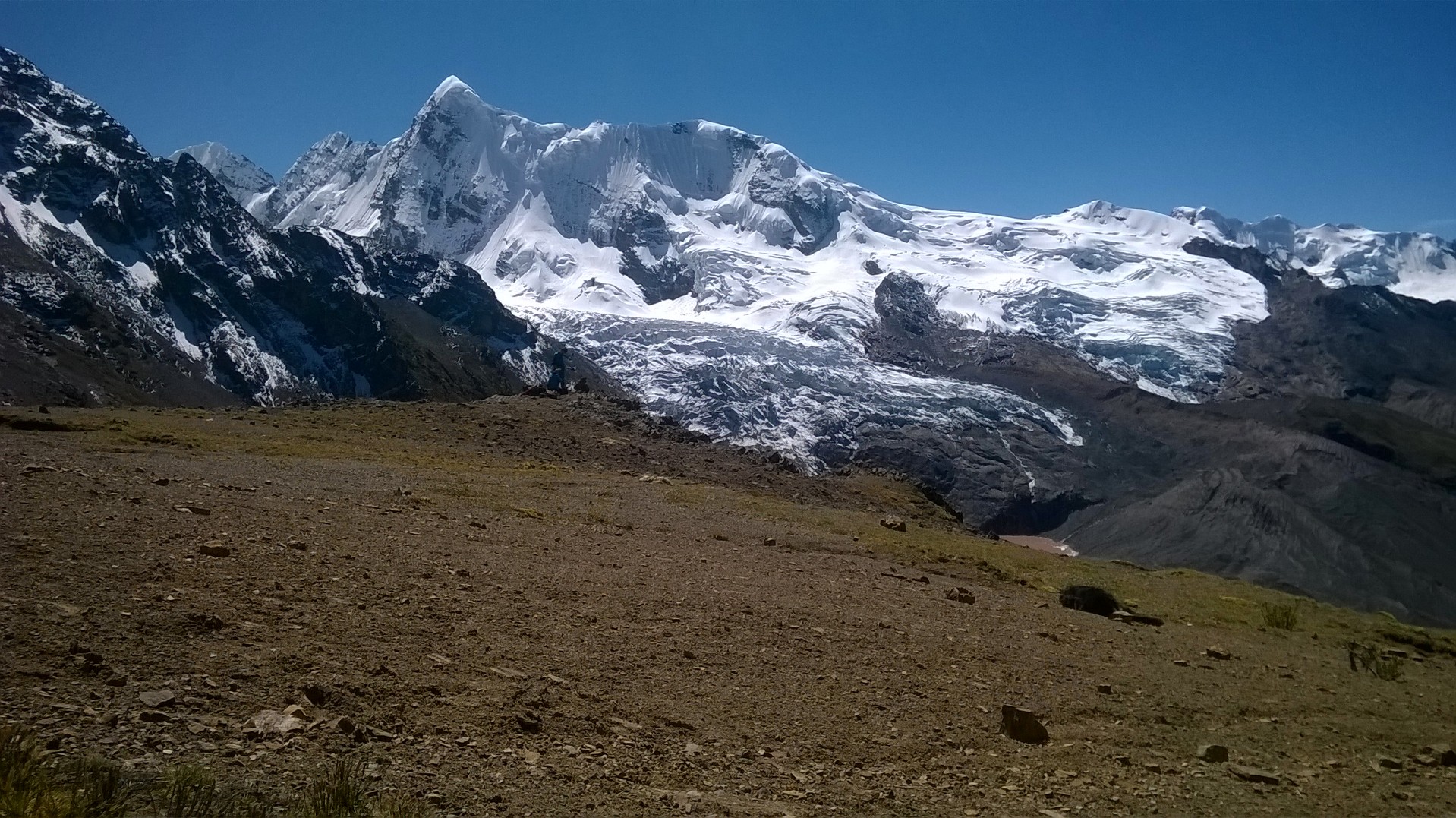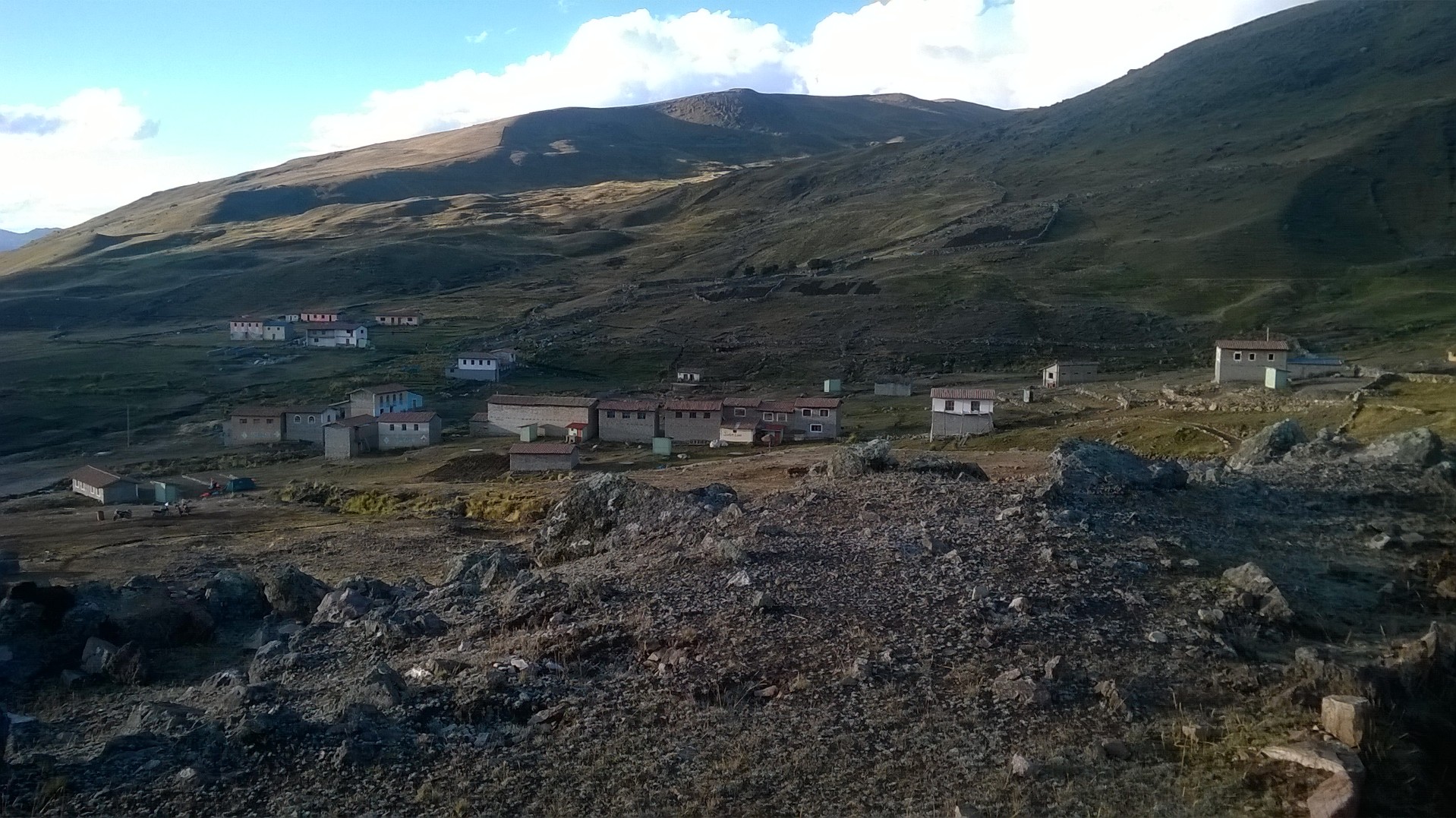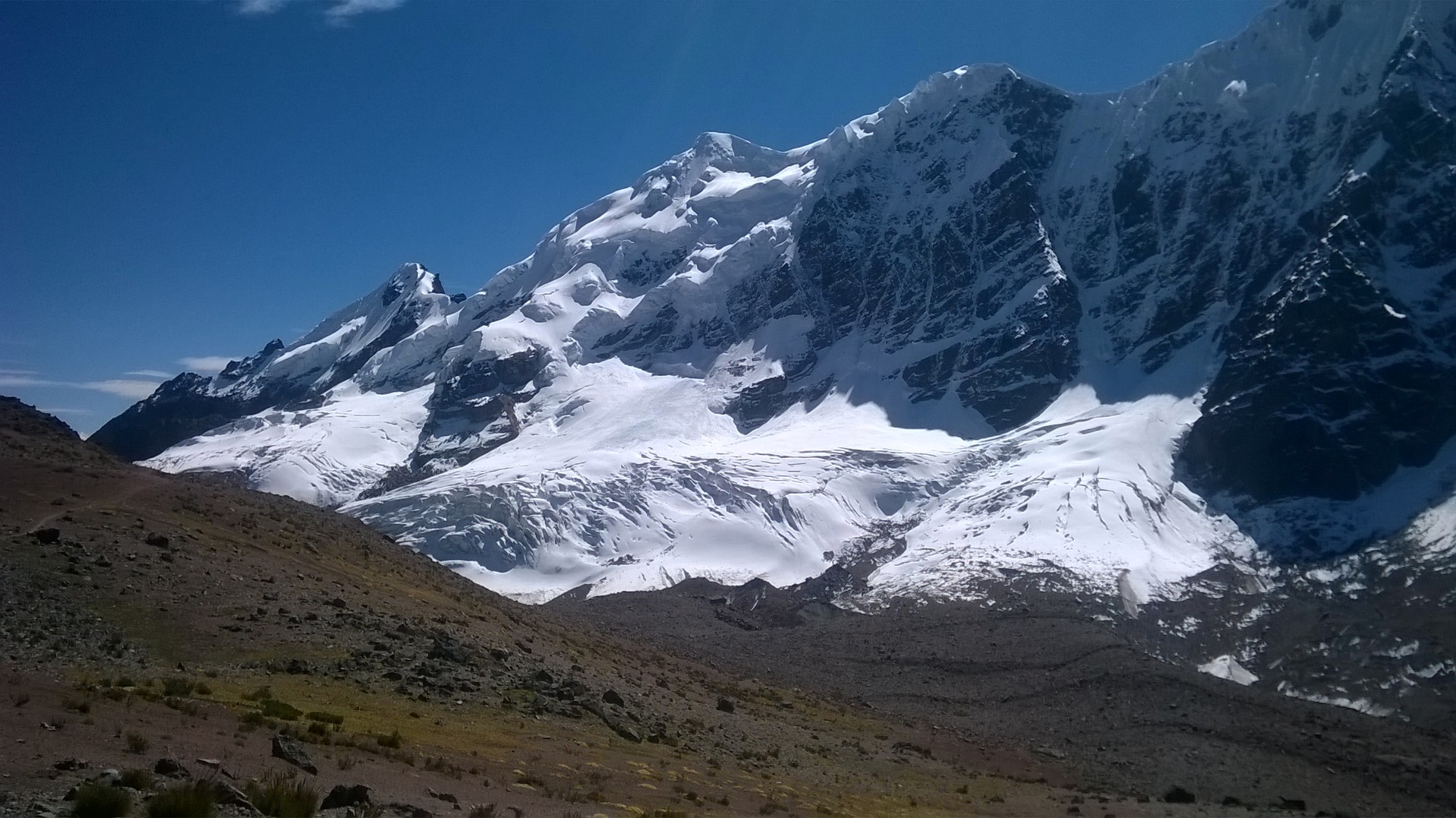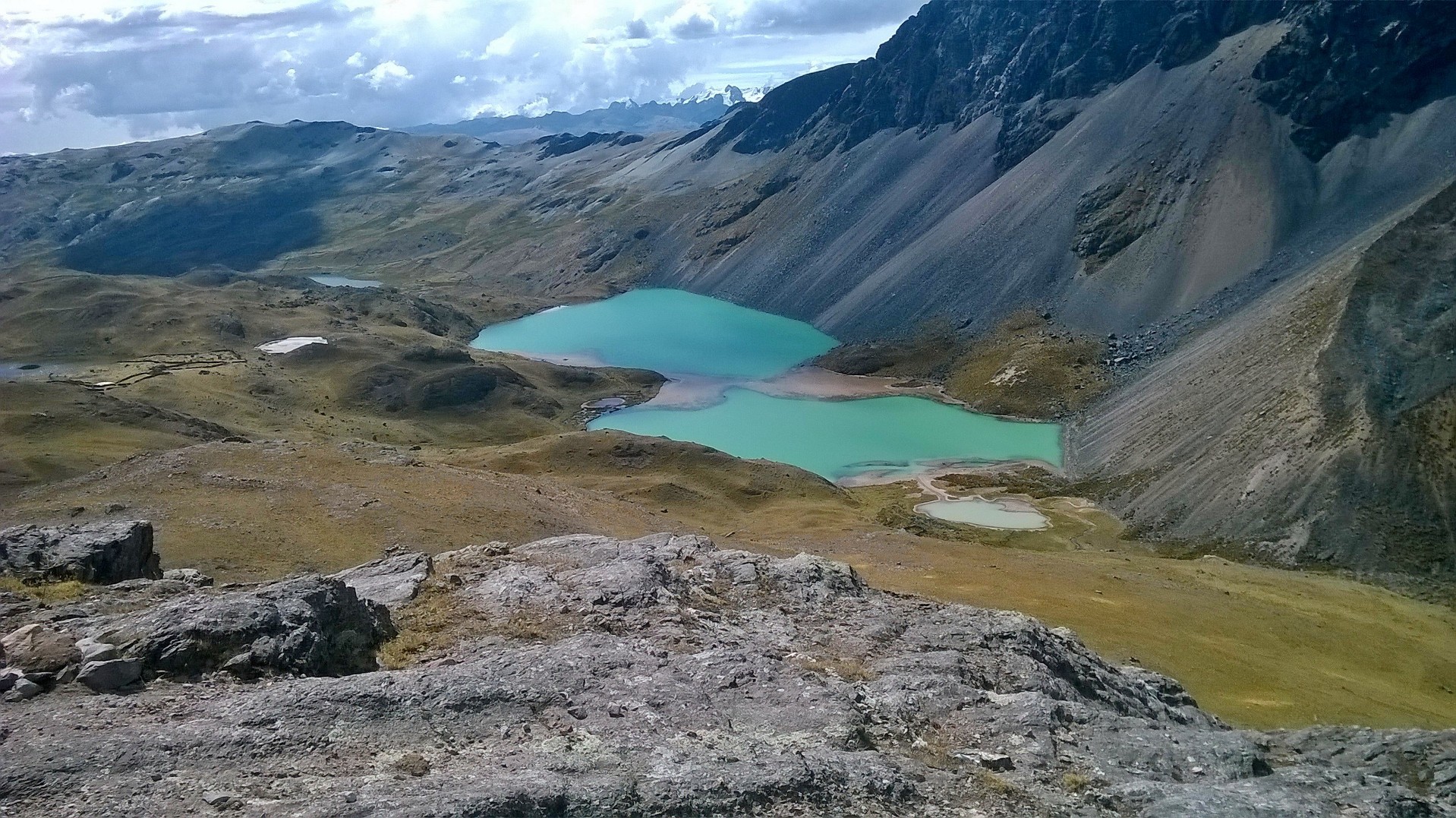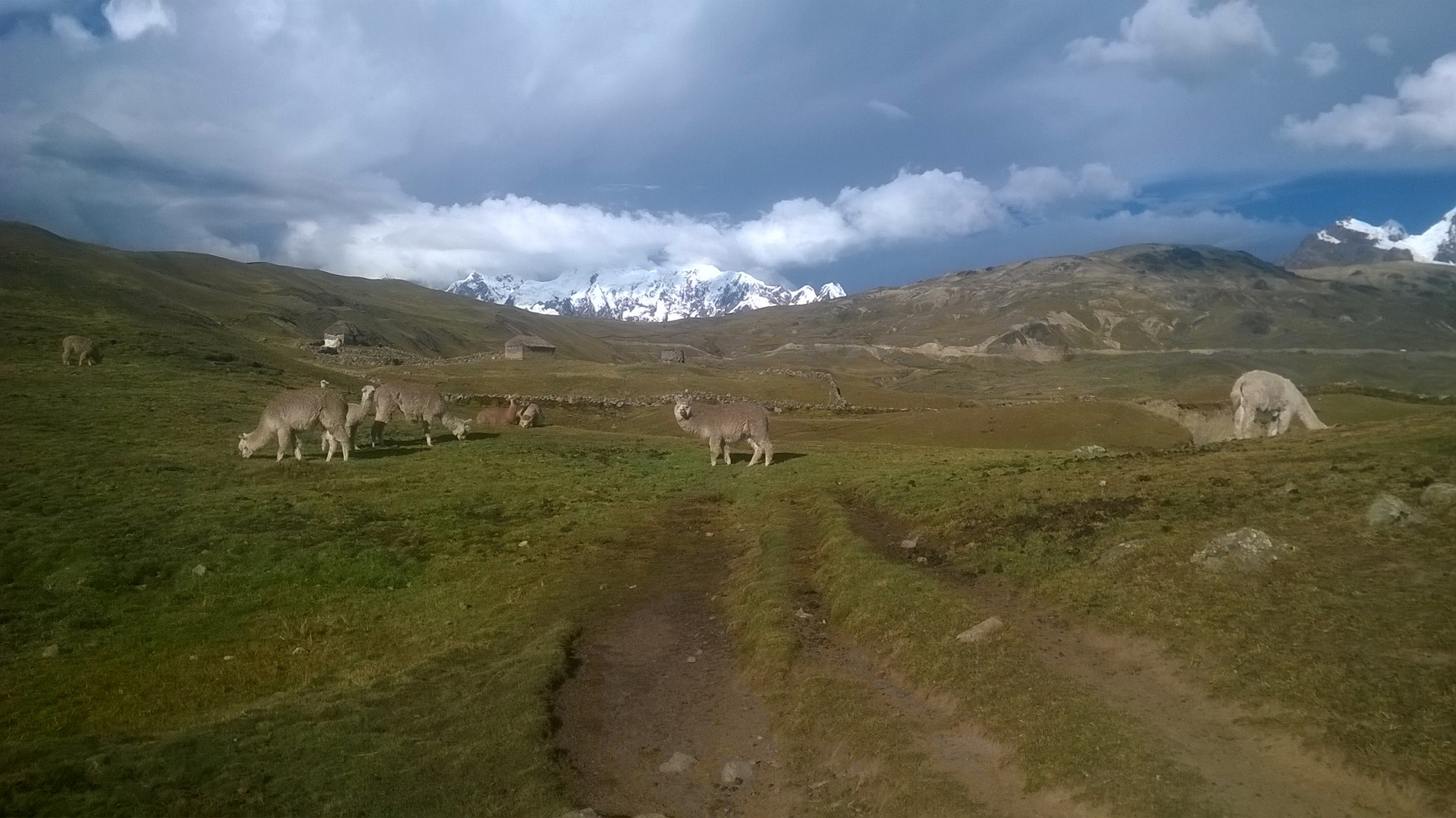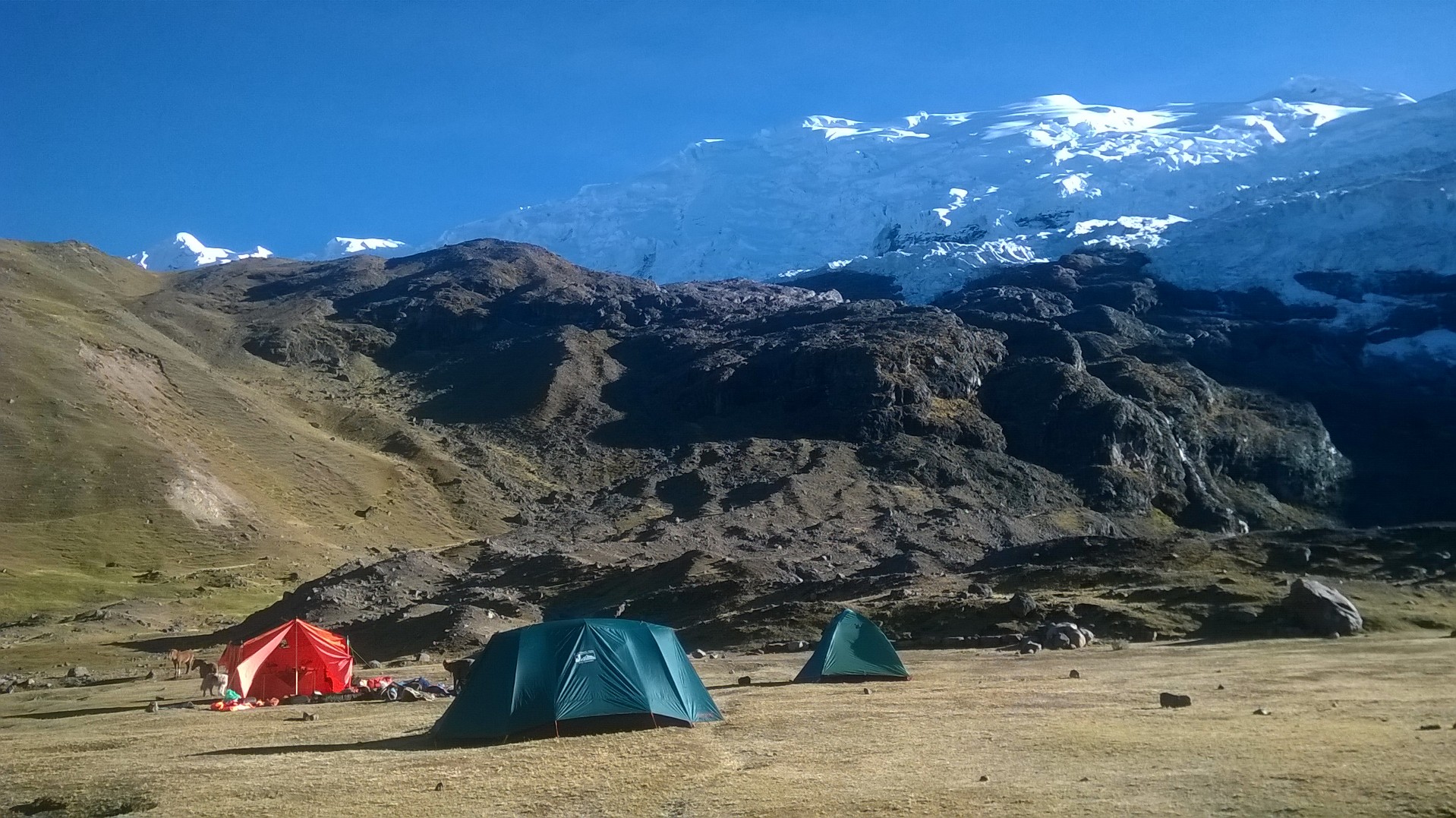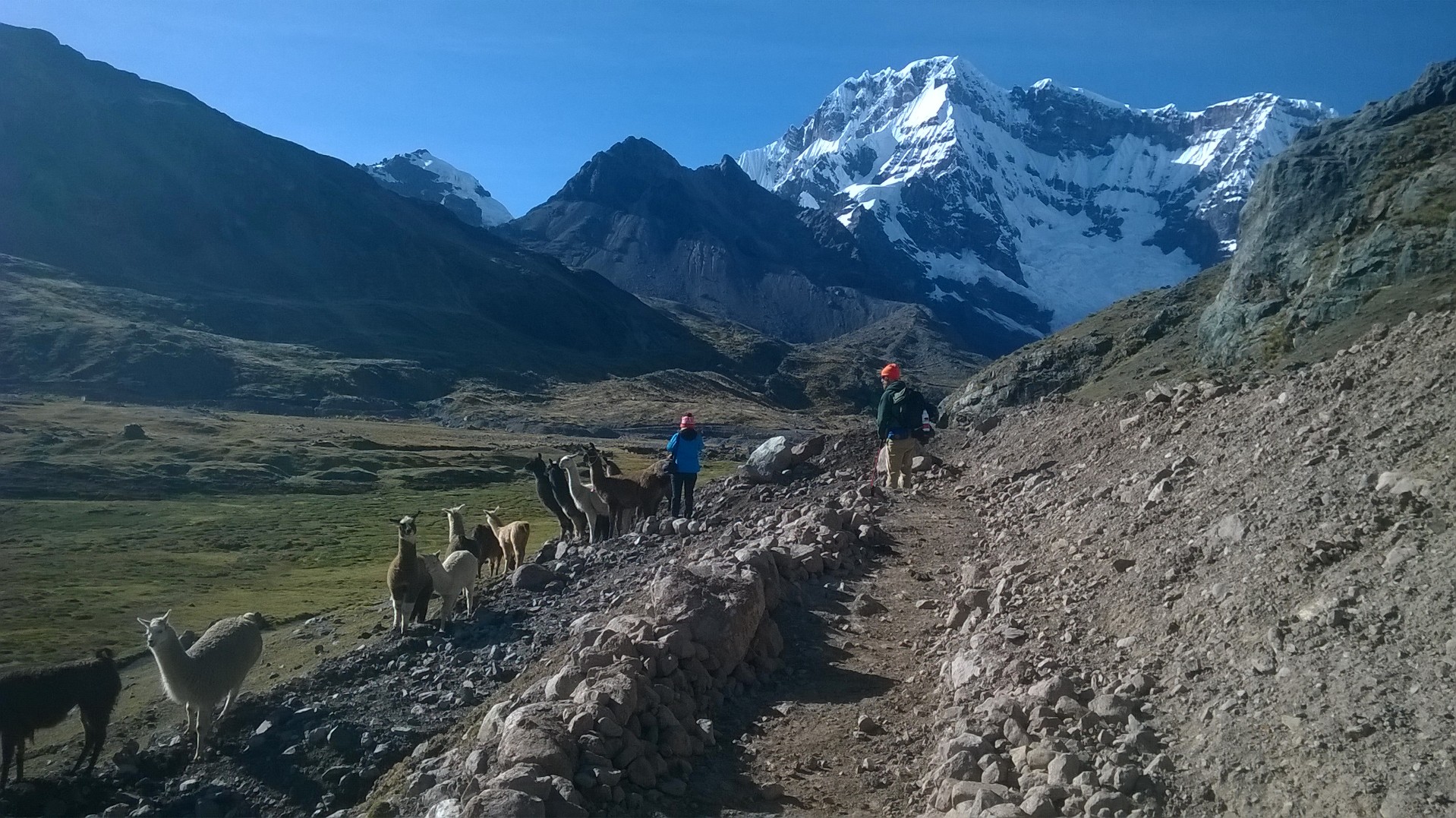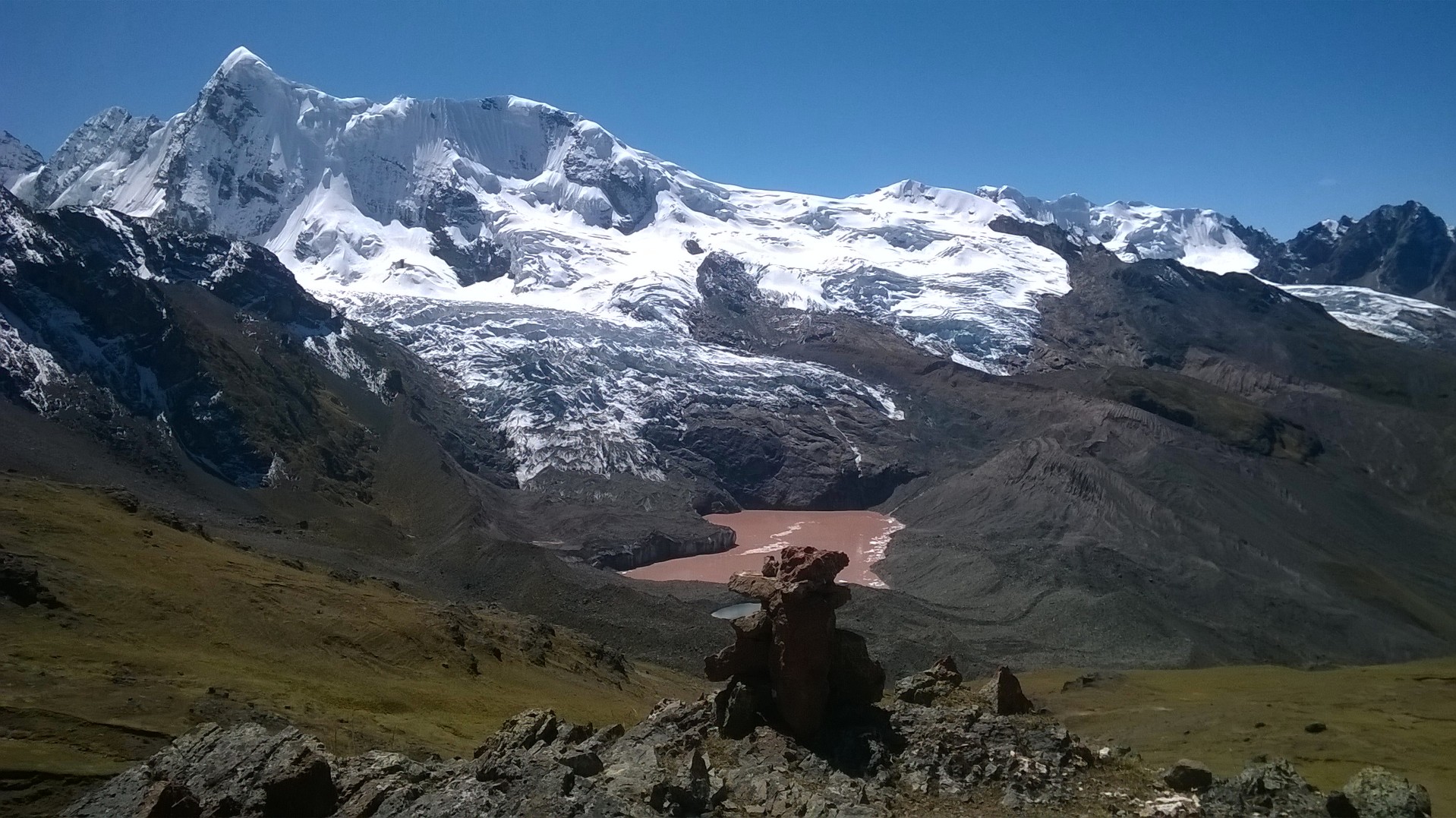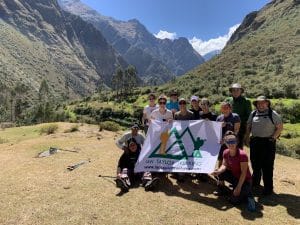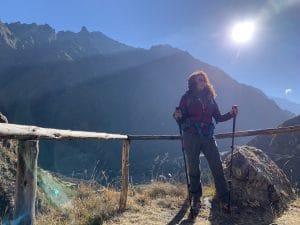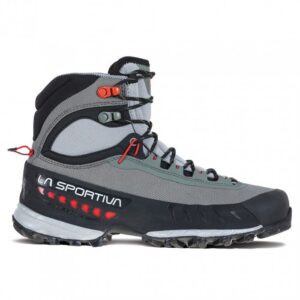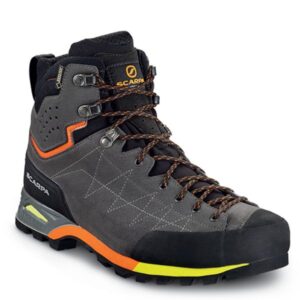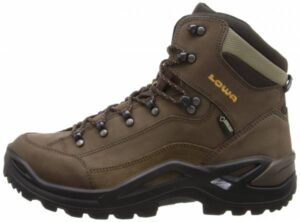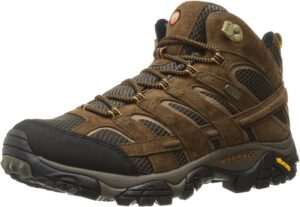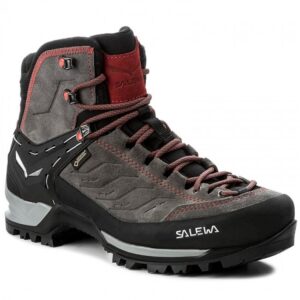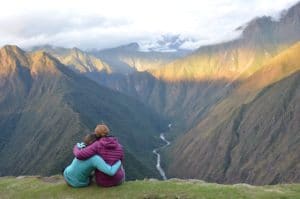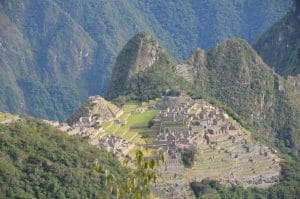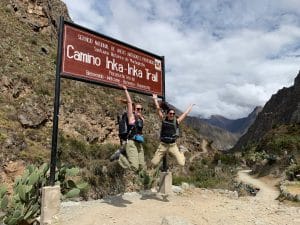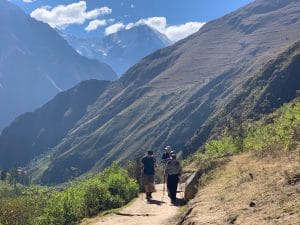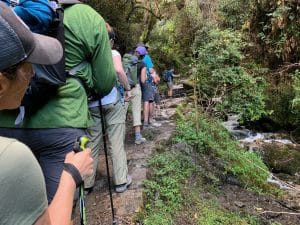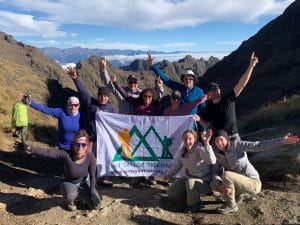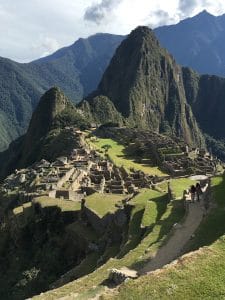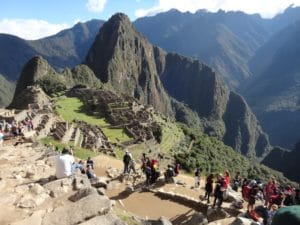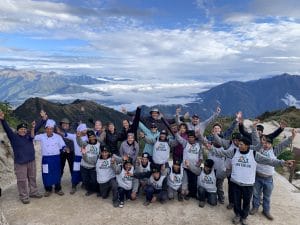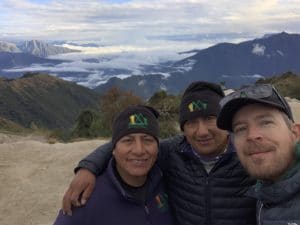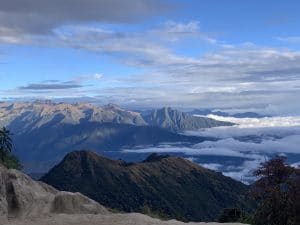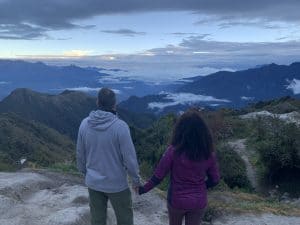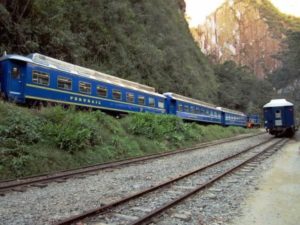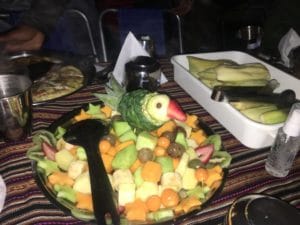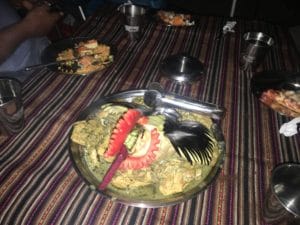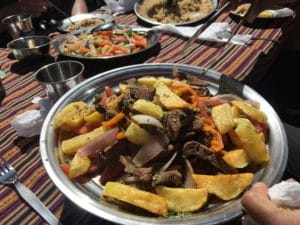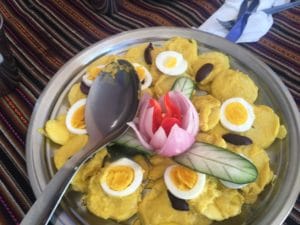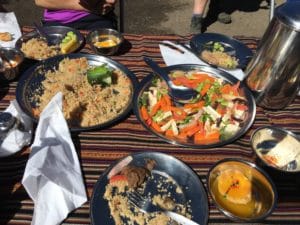Ausangate Circuit Trek
Ausangate is the highest and most sacred mountain in Southern Peru, and for centuries has been central to the religious beliefs of the Andean people who still go on annual pilgrimages to its icy slopes.
Tips & Advice
If you have signed up to an Inca Trail trek to Machu Picchu, then you have decided to undertake one of the greatest adventures in the world! You will be immersed in the world of the Inca’s as you hike through amazing mountain terrain. This region of Peru is truly sensational. This trek and trip has it all. Rich culture, world class mountain viewing, great food, the wonderful city of Cusco, amazing side trips, along with extremely special people. Read some REVIEWS from our trips.
Over the past fifteen years of running trips to the magical Machu Picchu, we have compiled a list of everything you need to know about the trek. This information is to help you have all of the information you need to best pick your trip as well as how you will need to prepare. We run over 15 trips a year on the Inca Trail, following a number of routes and options. GET IN TOUCH today for more information, and then, sign up to one of our unique itineraries!
How Many Days do I Need to Make This Journey?
After each time we get to trek the Inca trail to Machu Picchu, we start planning the next trip! No matter how many times we have been on this wonderful trek, we are still stunned and in awe of the Incan People. We run 15 treks to Machu Picchu each year and our favorite and most popular trek is our 5 day Classic trek to Machu Picchu. Also, we run 4 day and 6 day treks to Machu Picchu. We also run a number of side trips to Rainbow mountain, Ausangate, the Amazon region of Peru and the Lares region of Peru.
Everything you Need to Know
We have added some useful links below that will aid in your planning and preparation for your trek along the Inca Trail to Machu Picchu. We have successfully led hundreds of people through these majestic mountains. Therefore, hopefully this will aid in your preparation for the trip as well! Why not CALL US and find out everything you need for your specific trek.
1). Extremely IMPORTANT INFORMATION about Inca Trail permits.
2). Pick the best itinerary for your Inca Trail trek to Machu Picchu
3). Get training and learn the best way to prepare for your Inca Trail trek to Machu Picchu
4). Get FREE constant advice from our professional team
5). Understand the daily distance on the way up and down the Inca Trail Trek to Machu Picchu
6). Have the right clothing and gear for your Inca Trail Trek to Machu Picchu
7). Pacing each day on the trail is critical to success on the Inca Trail
8). Why being hydrated is critical at high altitude and in low oxygen environments
9). Elevation gains on the Inca Trail Trek to Machu Picchu. This will help you formulate a training plan
10). What sort of food will I get on your Inca Trail Trek to Machu Picchu
11). Read our Top 10 Tips for a successful Inca Trail Trek to Machu Picchu
12). Read our Top 10 Tips for when you are on the Inca Trail Trek to Machu Picchu
13). Read about the best time to trek the Inca Trail to Machu Picchu
14). What vaccinations should you consider for your Inca Trail Trek to Machu Picchu
15). What type of trekking boots should you have for your Inca Trail Trek to Machu Picchu
16). What Insurance do I need for your Inca Trail Trek to Machu Picchu
17). What additional expenses will you incur on the Inca Trail Trek to Machu Picchu
18). Here are 20 reasons to Pick us for your Machu Picchu Trek
19). Here is some additional training advice for going downhill
Pick the Right Itinerary to Match Your Ability
Firstly, you need to do is pick the right itinerary. There is no one size fits all. The trail can be challenging and therefore you should consider adding more days in Cusco and on the trail. Do not under estimate the lack of oxygen. Therefore, you need to make sure you pick the right acclimatization schedule and days on the Inca Trail to safely make your way through and to experience as many of the Inca sites as possible. Picking the right itinerary is vital for a safe, enjoyable and success experience in a low oxygen environment higher up the trail to Machu Picchu. If you fail to acclimatize well, then you run the risk of getting altitude sickness higher up.
How to be Successful When Trekking at Altitude
Breathing techniques, low heart rates, excellent hydration and pacing are all extremely important in order to be safe and successful. Also, you need excellent physical conditioning to be able to walk up and down thousands of steps, with a weighted back pack at high altitude. We can help you with this. DROP US AN E-MAIL today and get access to our Inca Trail trekking professionals. Our office staff have personally trekked the Inca Trail to Machu Picchu more than 10 times. Pick up the phone and speak to us. We have the team, experience and knowledge to help you come fully prepared for your Inca Trail Trek. Therefore, you need to get in touch today!
Why you need to pick Ian Taylor Trekking for your Inca Trail Trek
Support a company who has invested in their local staff. We have raised funds to build a school in Uganda, two schools in Nepal, support an orphanage in Tanzania and also help support local children in Cusco. We have our own full time staff on the ground in Cusco and we run a quality service on all our trekking trips to Machu Picchu. CONTACT US and we can explain how we operate our adventures in Peru.
The trek to Machu Picchu will be the highlight of any trekkers career! Thus, you need to make sure you put in the right training and preparation to make this journey a success. Let our team help you to reach your goals today!
We lead between 10 and 15 treks along the beautiful and historical Inca trail to Machu Picchu each year. Most people go for our 4 day traditional trek, however, in our opinion, the 5 day classic trek is the best way to experience this famous trail. Our 6 day Salkantay trek to Machu Picchu is for the more adventurous trekker and encompasses 90% of the traditional Inca trail. Check out our upcoming trips.
We have come up with our tips for a safe and successful trek on the Inca Trail. While this is a trek that most trekkers can comfortably complete, you want to make sure you are putting in the correct training and preparations. If you sign up to one of our trips, we will send you a complete dossier with all the information you need. Read some reviews from our trips. If you are still deciding if you want to do the trip, then here are 20 reasons you should pick us for your Inca Trail Trek.
1). Picking the Right Itinerary is Critical
We highly recommend the 5 day classic itinerary. With new restrictions in the city of Machu Picchu, anyone entering the city is limited to just two hours. The 5 day itinerary gives you more time on the trail to experience every site along the way. This itinerary also gives you two visits to the city of Machu Picchu. We walk in through the famous Sun Gate in the late afternoon on the 4th day. This itinerary sleeps in the best locations on the trail with less people around you. You get to spend more time in Winyawayna, before having a beautiful lunch and then walking in to Machu Picchu.
Our 5 day itinerary also includes a night sleeping in the beautiful town of Aguas Calientes. After a well deserved shower, we will treat you to dinner in Indi Feliz to celebrate your success. The next morning, we will go back up to Machu Picchu for our second visit. On this day we will explore the ruins and do a full guided tour.
2). Make Sure you have the Correct and Specific Training
Trekking the Inca trail to Machu Picchu is a 26 mile trek over 4 days of walking. You will be starting at 2,800m/ 9,186 feet, trekking up to 4,215m/ 13,829 feet and ending back down at 2,450m/ 8,038 feet. This trek should not be taken lightly. You will trek over a number of passes, steep ascents and descents, and thousands of rocky, uneven steps. Therefore, if you have not put in the training beforehand, you will definitely struggle on this uneven trail. Putting in at least four days a week training is essential. Walking in the hills, rocky terrain or just up and down steps, will give you the best chance of enjoying your journey.
You do not want to just endure the Inca Trail, you want to enjoy it! If you are signing up to one of our trips, we are happy to help you with your training and set personal training plans.
3). Break in your Trekking Boots Before the Trip
Make sure that you get the right boots and break them in. Having the right boots are an absolute must on this trek! You will be wearing these boots day in and out, along the extremely uneven and rocky trail. Do not arrive to the Inca Trail with a new pair of boots that you have not taken the time to break in. This could make for a long and uncomfortable trek! Make sure that you have a pair of boots that you have worn in the elements and broken in on trails. A good amount of ankle support is also a must. Make sure that your boots are waterproof, as you are likely to encounter moisture, either in the form of rain, snow or both on the trail. READ MORE.
4). Have all the Right Clothing and Gear
We want to make sure that all of our clients have the right gear, especially your waterproofs. The gear you bring with you on the trek can be the difference to your enjoyment levels on the trail. There are a few bits of gear that are essential in order to set yourself up for success: your waterproofs and layers. It is almost a guarantee that you will encounter rain on the trail, no matter what time of year you go. Therefore, you need to be prepared for all weather. Having a good waterproof jacket and pants will mean that you do not have to spend the 4 days on the trail wet and cold, which can definitely make or break your trip!
Another part of gear that I would suggest you focus on is your layering system. The temperatures on the trail can sometimes drop below freezing. And other times it is quite warm. This means that you will need the right layers as well as a warm down jacket. I like to focus on wearing Merino Wool base-layers, however, they are quite expensive. Therefore, if you don’t want to spend the money on wool, I would stick with a good synthetic fabric. Do not show up on a trip with cotton layers as they will not dry quickly or help with regulating body temperatures. You will always want to have a good down jacket as well to put on in the mornings and evenings, when the temps drop! If you need more information on what gear to choose, please feel free to get in touch.
5). Book Far in Advance to Avoid Disappointment
The Inca Trail is regulated by the government of Peru and therefore strict regulationshave been put in place. The trail only allows for 500 people per day to be on it, including all porters/guides/cooks and tourists. This can limit your chance of being able to book a trek, unless you plan far in advance. You have to book your place on a trek no later than 6 months before you plan to travel, in order to get your spot booked. If you arrive in Cusco with plans on going on the Inca Trail, without having booked prior, you will likely be disappointed. There are however many other treks into Machu Picchu that you can take. However, if you want to be on the actual Inca Trail, you must book in advance!
6). Pick The Best Month for your Trek
Pick your dates to best suit your desires. While you can hike on the Inca Trail year-round, there are definitely months in the year that have more suitable weather to take your journey than others. The months of May through September generally give you the best chance of being on the trail with the least amount of rainfall. Most likely you will always see precipitation on the trail, no matter what time of year it is, however if you go during the months of May – September, the chance of rainfall is lower than at other times.
7). Arrive in to Cusco Early for Additional Acclimatization
The beautiful town of Cusco, Peru sits at 3,400m/ 11,152 feet above sea level. If you are flying in from sea level, this is quite a large jump to take. You may feel the lack of oxygen and possibly even signs of altitude sickness on your arrival. It is not a good plan to start the Inca Trail after only one night sleep in Cusco. If time allows, you should sleep at least two nights in Cusco. This will give yourself that much needed time to acclimatize.
All of our trips on the Inca Trail include two nights in Cusco at the start of the trip. Also, we will take one day to do a full day tour of the Sacred Valley to aid in your acclimatization process. The start of the Inca trail is actually at a lower altitude than Cusco, so if you give yourself that much needed time in the City, you will definitely feel the benefit when you start hiking. There is also plenty of things to see and do in the city to spend the extra time!
8). Hydration is Critical
Drink, Drink, Drink. Water is your best friend at altitude! Keeping yourself hydrated at altitude is extremely important. Your body dehydrates much quicker at altitude. Therefore, you need to replenish your fluids and drink a lot more water than you may do back home. I always try and drink anywhere from 4 to 5 liters a day when at altitude. If your follow this rule, you will combat altitude sickness and keep yourself feeling good throughout the trip!
9). Be Prepared for the Outdoors
The Inca Trail to Machu Picchu is one of the World’s most beautiful and well-traveled trails. It is accessible to most people out there who are avid walkers/hikers, however, it is still the outdoors and you have to be prepared. Not only do you have to deal with the difficulty of hiking and the weather on the trail, you need to prepared to have to live in the outdoors for 4 nights. This means that you will be walking, sleeping, eating, and going to the bathroom in the wilderness. Therefore, you need to be comfortable with all of these things.
Our trips carry our own toilets with us on the trail for your comfort. Likewise, there are some toilet facilities in the campsites for use, but along the trail, you will need to use the great outdoors as your facility! Always remember to carry a small bottle of hand sanitizer so that you can keep bacteria off your hands. You also want to make sure you have the right vaccinations for your Inca Trail trek to Machu Picchu.
10). Pacing Yourself on the Trail
One of the biggest mistakes people make while on an altitude trekking trip is to over exert on the trail. You don’t want to be in a position that you are out of breath and fatiguing your muscles when trekking. Likewise, you want to avoid having a high heart rate while walking on the trail. You need to keep the pace at a slow and controlled speed to make sure that these things don’t happen. If you feel that your guide is going too fast, then slow down and take it at the speed you need to be comfortable. It is not a race to the finish line!
Get in Touch Today for More Information
Get ready for some of the most amazing experiences of your life. CONTACT US and learn more about our quality run Inca Trail trips. The Inca Trail to Machu Picchu is one of the world’s greatest and most beautiful treks. Following in the footsteps of the Inca people to the great city of Machu Picchu will undoubtedly give you some of the most beautiful and unique views that you have ever seen! Make sure you have brought your good camera, a solar charger (or spare batteries) and an open mind to view this beautiful trail!
I hope you enjoyed these top 10 tips for your Inca Trail Trek to Machu Picchu. If you would like to read more why not check out our TOP 10 TIPS while you are on the Inca trail to Machu Picchu. For more information on our treks and booking your trek to Machu Picchu, contact info@iantaylortrekking.com
Congratulations on signing up to an Inca Trail trip to Machu Picchu! This will surely be the highlight of your trekking career. We want to make sure that you have all of the information to make a safe and successful journey on this historic trail. Here are our top 10 tips for when you are on the Inca Trail to Machu Picchu. Over the past 12 years we have developed our service along the Inca Trail, running 10+ trips per year. Here are 20 reasons to chose Ian Taylor Trekking for your Inca Trail trek.
Pick the Best Itinerary
Over the past 12 years, we have been developing our itinerary to Machu Picchu. We have offers to trek on the Traditional 4 Day trek,the Classic 5 day trek and the 6 Day Salkantay trek. However, our favorite itinerary is the 5 day Classic Inca Trail trek. This itinerary allows more time in the sites along the trail and even gives you two visits to the town of Machu Picchu. There are less people on the trail each day and you get to experience camping at some of the more beautiful sites around! Also, you can check out our Top 10 Tips in preparation for your trek after you have read these tips.
Think about Additional Acclimatization Before the Trek
Before you read our top 10 tips, you really need to consider having more nights acclimatization in Cusco and along the trek. You need to carefully select the right itinerary for your adventure. Our team in the office have all trekked on the Inca Trail numerous times, and we have all of the information you need! Feel free to GET IN TOUCH today, and schedule a time to call with us!
Having additional nights acclimatization will give you the best chance at being successful, safer and getting the most of your experience along this famous trail. You get one shot, so you need to pick the right itinerary for you. Having a more flexible itinerary might make a big difference in the experience you have.
1). Manage Your Heart Rate
Pacing, heart rates and attention to breathing are all super important as you come up hill over the 3 passes. This is especially important on the Dead Women’s Pass, up to 4,215m/ 13,829 feet. In the more challenging areas and days, you will walking up and down steep steps, so holding a slow, controlled pace will be critical to your recovery and your ability to complete this journey in a safe manor. You also need to come in excellent physical conditioning for this trek. We want you to enjoy and experience all the Inca sites along the trail. Focus on deep breathing, in through your nose and out through your mouth. Your goal should be to keep your heart rate as low as possible at all times on the trail.
2). Be Aware of Your Surroundings
Keep a close eye on your surroundings. There are lots of porters rushing past you on the trail, therefore you need to stay on the mountain side of trail so you do not get knocked off. If you see porters coming, do make your teammates aware so they can safely move to the mountain side of the trail as well. This is especially important on the way down the steep steps that the Inca trail presents. They are steeper than you think so you do need to manage your own safety on the trail. Your personal safety needs to be your main concern at all times on the trail.
3). Stay Away From any Drop-off Areas
Always stay on the mountain side of the trail. With high drops offs and risky uneven trails, you always need to be aware of your foot placement and stay away from the edge of the trail. There are a very few railings on the trail. Therefore, you need to stay on the mountain side of the trail. Stay well away from drop offs at all times. There are some very steep steps downhill sections and you need to stay well away from drops offs and manage each foot placement.
4). Treat all Cold Water on the Trail
Make sure you treat all cold water throughout the trek. On all Ian Taylor Trekking Inca Trail treks we boil all the water. However, you do not want to get sick from untreated water. If you get served cold water in your bottle on the trail, you MUST treat the water with water purification tablets before you drink it. Drinking dirty water will ruin your trip. You can not buy bottled water on the Inca Trail to Machu Picchu. If you are given hot water for tea, coffee or in your bottle, then it is fine to drink without tablets. Make sure you manage your personal hygiene each day on the trail. This can make or break your trek.
6). Acclimatize in Cusco
Exercise is an important part of the acclimatization process. Coming into Cusco early and walking around the town and surrounding hills is very important. Exercise is important but you do not want to fatigue your muscles by pushing high heart rates. Once you have come prepared and trained, this should not be a concern. We include two nights in the hotel in Cusco before each of our Inca Trail trips.
On the trail, you will be walking 8 hours back to back, with 30% to 40% less oxygen than your body would be used to having at sea level. This will put your muscles, heart and body under a lot of pressure. You do not want to be moving fast up the trail each day. Our pace will be slow and steady, with plenty of breaks, especially on the longer hills. You need to regulate your heart rate, as you hit every uphill along the Inca Trail.
7). Hydration, hydration, hydration
The dry climate and low oxygen level require you to be drinking 4 – 5 liters of water each day. There is NO exception to this rule! Hydration is critical for body to function correctly at altitude. The International Society for mountain medicine defines high altitude as between 1,524m/ 5,000 feet and 3,500m/ 11,500 feet, very high altitude as between 3,500m/ 11,500 feet and 5,486m/ 18,000 feet, and extreme altitude as any height above that. The higher you go, the greater the effects are on your body and the more important it is to stay hydrated.
We dehydrate much faster at high altitude. When you fail to stay hydrated, you run the risk of altitude sickness and ultimately ruining your trek. You may not realize how much water you are losing through exertion, but the lower oxygen levels make you breathe in and out faster and more deeply, consequently, losing more water through respiration. According to the wilderness medical society, you lose water through respiration at high altitude twice as quickly as you do at sea level. High altitude can also make you need to urinate more often and can blunt your thirst response, putting you at even greater risk of dehydration.
8). Do not Ignore the Signs of AMS
Do not ignore the signs of AMS, or Acute Mountain Sickness. Our Inca Trail Treks have quality acclimatization in Cusco. It is extremely important to sleep at 3,400m/ 11,152 feet, for two nights before the trek. You need to be able to manage your ascent safely and never be afraid to let your guide know how you feel. Altitude sickness can kill, so respect the mountains and respect the decisions our guides make. Our guides are trained to deal with altitude sickness so let them help. We carry oxygen on all our treks. Once you get sick it will only get better by going to lower altitude as quickly as possible.
9). Stay Together at all Times
You are trekking as a team, not individuals. You need to look out for yourself and other people around you on your trek. Team work is essential for safe group travel. Look out for each other, and you will enjoy the journey a lot more. If people cannot keep our minimum pace they should be turned around before they become a risk to themselves and the team. Please let the guides know if a team member is feeling unwell.
10). Have the Right Gear
Have the right clothing, gear and equipment. There are too many people on the trail with cotton clothing, poor quality trekking boots, small insufficient day packs, and the wrong clothing with minimal water. Do not compromise on trekking boots, back packs, water proof gear, air mattress or sleeping bags. Check out our PACKING VIDEO. If you are signed up to an Ian Taylor Trekking trip, we will provide you with an itemized kit list in our 35 page dossier.
Even if you are trekking in the best months to trek the Inca Trail, you still need good gear, as it can rain on any day on the Inca Trail to Machu Picchu. You need to make sure you have a proper light weight day pack, that is at least 25 liters. It will need to hold 2 – 3 liters of water, waterproof rain gear, down jacket, poles, sun cream, personal medication, liner gloves, your personal first aid kit and other personal kit you may need. On any given day you could experience any weather, so make sure you have the right gear each day as you walk this magical trail to Machu Picchu.
Get in Touch Today
Hopefully you have found our top tips while you are on the Inca Trail helpful! We are experts on the Inca Trail, and want to make sure our clients have the right information for the trip! Read some REVIEWS from our clients, and SIGN UP TODAY!
Preparation & Training
Congratulations, you are off to trek the Inca Trail to Machu Picchu! Hopefully you are going on an Ian Taylor Trekking trip! There are a lot of factors you need to consider when you are preparing for your Inca Trail trip. The daily distances you will cover will also depend on what itinerary you have chosen to take. Our favorite itinerary on the Inca Trail is the Classic 5 Day trek. This will give you a better idea of how much distance you will cover each day on the 5 Day trail.
Once you have looked at the daily distances on the trail, then you should read about the elevation gains on the Inca Trail. These two combined should then give you a better idea of how you want to train and prepare. You have to walk up and down hill quite a bit on mixed rocky terrain. Most of the time, this will be on steep steps up and down. Therefore, you have to make sure you have the conditioning in the legs and body to handle the distances and more importantly the steps. You need to focus on strength and endurance training for this type of hiking. We are available to discuss training with you at any stage. Read some REVIEWS from our trips.
Daily Distances on the Inca Trail to Machu Picchu
Day 1). Llactapata
The Inca Trail starts with the transfer from your hotel. You will be picked up from the hotel at 7 o’clock in the morning and will have 3 hours and a half hour drive. Our teams will make a stop in Ollantaytambo, to buy a few final supplies, and stop for a short break. Then, you will continue about another 40 minutes in the car until you reach Piscacucho at 2,700m/ 9,000 feet. This is the KM 82 marker and starting point of our trek. After checking in and showing passports and permits, the trek will begin! After approximately 5 – 6 hours of walking today, we will reach the Inca City of Llactapata 2,750m/ 9020 feet. From this point, we descend to the ruins, next to which we set our camp.
The Total time trekking today is approximately 5 – 6 hours and you will cover a distance of 10k/ 6 miles. The highest elevation reached today is 2,950m/9,676 feet.
Day 2). Llulluchapampa
We wake up early to continue trekking along the valley created by the Kusichaca river, gradually climbing until we reach the farming community of Wayllabamba 3,100m/ 10,170 feet. With a stunning walk through the forest today, we will enjoy the diverse wild flora and fauna that can be found all along the valley. We will be making our way approximately half the way up the Abra Warmihuañusca, otherwise known as the Dead Woman Pass. After a tough uphill climb, we will then reach Llulluchapampa camp 3,850m/ 12,589 feet, where we camp and spend the night.
The distance today will cover 12 km/ 7.46 miles and will take approximately 6 hours. The high point of the day is where we will camp, at 3,850m/ 12,631 feet.
Day 3). Phuyupatamarca
Day 4). Machu Picchu – Aguas Calientes
After our delicious breakfast accompanied by the “Apus” sacred mountains we will descend for about three hours on steep steps, before arriving at the lunch place we will have an amazing view of the Urubamba valley from the place called Intipata. We will continue the descent for half an hour we will visit one of the most impressive places in all our route of the Inca Trail the place called Wiñayhuayna. We will hike back the same way, where will have our last lunch on the Inca trail and the opportunity to thank our porters team and the cook for the great experience we had in this Inca trail.
After lunch we follow a narrow trail that walked around Machu Picchu mountain leads us all the way to the Sun Gate (intipunku) and veiws down into Machu Picchu. After enjoying the Inca citadel we will descend for about an hour further before arriving down into the City. We will take photographs and enjoy the beauty of the city before we take the bus from the Inca city of Machu Picchu to Aguas Calientes. We will spend the night here in a hotel. Around 7 o’clock at night we will have a great dinner at the famous Indio Feliz restaurant.
The total distance walked today is 11 km/ 7 miles and will take approximately 5 hours. The highest point on the trail today is 3,680 m/ 12,073 feet.
Day 5). Machu Picchu – Cusco
We wake up early and board a bus, which will take us back up to Machu Picchu. There, we begin a complete guided tour of the Inca citadel that will take approximately two hours. We will then have free time to walk around, climb up the Huayna Picchu Mountain if you booked it(additional cost), where one can experience spectacular views of all of Machu Picchu. In the afternoon, we head back down to Aguas Calientes where we will take the train back to Ollantaytambo. Finally, by private bus, we will return from Ollantaytambo to Cusco, where we arrive after nightfall. Today you will only be walking through the town of Machu Picchu!
Get in Touch Today
The Classic 5 Day Inca Trail is our favorite itinerary to the beautiful city of Machu Picchu! This itinerary gives you more time to enjoy each of the sites, including two visits to Machu Picchu! READ MORE about why this is the best itinerary!
If you want to make the journey to Machu Picchu on the Inca Trail, then GET IN TOUCHtoday! Let us help you make this incredible journey with the Incas!
The elevation gains on your Inca Trail Trek to Machu Picchu will depend on what route you choose to take. There are many ways to hike on the Inca Trail, including the Traditional 4 day Inca trail, the Classic 5 day, or the 6 day Salkantay trek. Our favorite trek is the Classic 5 Day Inca Trail, therefore, that is the elevation gains we will explain here.
Daily Distances on the Classic 5 Day Inca Trail
After helping over 1,000 people trek this famous trail to Machu Picchu, we want to share as much information as possible with you. This information is to help you understand what will be expected of you when you are hiking each day, and therefore, be able to formulate an appropriate training plan. When you are finished on this page, then come back up and click this link for all you need to know about trekking the Inca Trail. For more information on our treks, GET IN TOUCH today!
Days 1 and 2). Cusco – Sacred Valley
If you are on an Ian Taylor Trekking trip, we include two nights at the beginning of the trip in Cusco, Peru. When you are flying into Cusco, which sits at 3,400m/ 11,152 feet, it is extremely important to spend 2 nights at this elevation before going onto the Inca Trail. The more time you can spend at this altitude before starting the trek, the better!
We will spend the first day in Cusco, exploring the city and acclimatizing. Then, the second day, our teams will do a full Sacred Valley Tour. At this elevation there is 30% less oxygen than at sea level. You can always come in early, recover from jet lag, time zone changes and gain extra acclimatization for the climb. We have people joining our treks from around the world so it is important so make sure you are rested and well hydrated.
Day 3). Llactapata
Today, the journey to Machu Picchu starts! The day will begin with a pick up from the hotel after breakfast. There will be a three and a half hour drive through beautiful high Andean landscape, before arriving to Ollantaytambo. You will have a short break there to pick up any last minute items, before jumping back in the car. After another 40 minute drive, you will arrive at Kilometer 82, or Piscacucho, at 2,700m/ 9,000 feet. Once you have passed the control, where you will have to show your passport and permit for the trail, our journey will begin!
The walk today will take approximately 5 – 6 hours through beautiful landscapes. En route to our campsite, we will have lunch at the charming spot of Miskay 2,800m/ 9184 feet. The campsite tonight is is right next to the stunning Incan City of Llactapata, at 2,750m/ 9020 feet. Total distance walked today is 10k/ 6 miles. The lowest elevation reached today is 2,700m/ 9,022 feet and the highest point is 2,950m/ 9,676 feet.
Day 4). Llulluchapampa
After our first night spent in tents, under the starry sky, we will wake early for breakfast. The trek today will continue along the valley, until we reach the community of Wayllabamba, at 3,100m/ 10,170 feet. Here we will stop for lunch and have a short rest before we begin our up-hill ascent in the afternoon. The journey uphill travels through some of the most beautiful and dense forest terrain on the trek.
The trail leads us up towards the highest point of the trek, which we will pass tomorrow, the Abra Warmihuañusca, otherwise known as the Dead Woman Pass. We only climb half way up the pass, stopping at Llulluchapampa, where we camp and spend the night. The total trekking time today will be approximately six hours and we will cover a distance of 12 km/ 7.46 miles. The lowest point of elevation today is 2,750m/ 9,022 feet and the highest point is at our campsite, at 3,850m/ 12,631 feet.
Day 5). Phuyupatamarca
After breakfast, we continue our hike up the highest point in the Inca Trail, reaching the mountain pass of Abra Warmihuañusca, or the Dead Woman Pass, at 4,215m/ 13,776 feet. This will take approximately two hours. Immediately after the pass, we descend into the Pacaymayo valley at 3,500m/ 11,482 feet. From here, we then start to climb to the second pass, the Abra Runkurakay 3,970m/ 13,022 feet. Half way up, we visit the archaeological complex with the same name. After going over the pass, we descend towards Yanacocha (Black Lagoon) and enter the cloud forest to finally arrive at Sayacmarca, at 3,624m/ 11,887 feet.
Continuing up an easy climb, we arrive to Chaquicocha, which the lunch spot. After lunch, there is approximately another two and a half hours before we arrive at the third pass, the Abra Phuyupatamarca, at 3,700m/ 12,136 feet. We set our camp in Phuyupatamarca, which is one of the more beautiful camp spots on the trail. We will have the most astonishing sun-set, and enjoy our final evening of camping here. Today is a tough day and the total distance will be 15 km/ 9.32 miles. It should take us approximately 7 – 8 hours of walking today. The lowest point of elevation is 3,500m/ 11,482 feet, and the highest point is at the Dead Woman’s Pass at 4,215m/ 13,776 feet.
Day 6). Machu Picchu – Aguas Calientes
After our final delicious breakfast at our campsite, we will begin the final day of trekking into Machu Picchu! The start of the day will be a steep descent, down stairs for approximately 3 hours. Here, we will stop for lunch with an amazing view of the Urubamba valley from the place called Intipata. We will continue the descent for half an hour we will visit one of the most impressive places in all our route of the Inca Trail the place called Wiñayhuayna.
After lunch, we follow a narrow trail that walked us around Machu Picchu mountain. Eventuatlly, we will reach the Sun Gate (Intipunku). Here, finally our dream becomes reality as the impressive view of the Inca Citadel of Machu Picchu will be in full display. After enjoying the Inca Citadel we will descend for about an hour we arrive at the place called the Guardian’s House. This is where we will have the opportunity to contemplate Machu Picchu in all its splendor. We will take photographs and soak in the beauty of Machu Picchu for a while. Then, we will take bus from the Inca city of Machu Picchu to Aguas Calientes. Once you arrive in Aguas Calients, you will be rewarded with a warm shower, a bed to sleep in and a fun night out on the town!
Today, we will be walking for approximately five hours and cover a total distance of 11 km/ 7 miles. The lowest point today will be in Aguas Calientes, at 2,040 m/ 6,691 feet and the highest elevation is at 3,680 m/ 12,073 feet.
Day 7). Machu Picchu – Cusco
After a wonderful night sleep in the hotel, then we will wake up early and board the bus. This will take us back up to Machu Picchu. Here, we will begin a complete guided tour of the Inca Citadel that will take approximately two hours. We will then have free time to walk around, climb up the Huaynapicchu Mountain if this was booked prior (additional cost), and soak up the beauty of this historic place. In the afternoon, we meet back in the town of Aguas Calientes where we will then take the train back to Ollantaytambo. From there, we will have a private bus back to Cusco, where we includ one final night in the hotel.
Day 8). Onward Journey Home
Your classic 5 day Inca Trail Trek is over. You will be picked you up from your hotel in Cusco, depending on your flight time. We will drive you to the airport in order to take your flight for your onward journey. There are options to join tours to the Amazon, lake Titicaca and other treasures Peru has on offer.
Join us to Make the Journey on the Inca Trail
Why not join one of our Inca Trail treks. We will help you get the right training information so that you can come fully prepared for your trek. This is not an easy hike and should not be underestimated. Therefore, you need to come with the right strength and conditioning to be safe all the way through this Inca Trail to Machu Picchu. Read some REVIEWS from our trips and then CONTACT US.
The trek to Machu Picchu on the Inca Trail will be one of the highlights of any trekkers career and an incredible adventure. Although the Inca Trail is accessible to most relatively fit individuals, you definitely want to make sure that you are putting in the right training and preparation to make your journey a safe and successful one.
One thing to remember about the Inca Trail is that is heavily consists of stairs, going both up and down. This can be one of the most challenging parts of the trek and something that you want to make sure you are prepared for. Depending on what itinerary you choose to do will also play into how much training/preparations you need to do. We recommend our Classic 5 Day Inca Trail because it spreads out the walking to four full days of walking. The 5 Day trip also sees a LOT less people on the trail than the traditional 4 day option. GET IN TOUCH today for more information on the options for the Inca Trail.
What Does the Trek Entail
The total distance of the traditional Inca Trail is 33.7 miles. READ MORE. Pretty much all of this distance is on steep ascents and descents. You will cover 2,065m/ 6,774 feet of ascent and you will descend 2,265m/ 7,431 feet throughout the trip. Most of this is done over two longer days. For a lot of people, going downhill on the steps can be more challenging than the up-hill, so coming with the right physical preparations are essential. You don’t want to endure the Inca Trail, you want to enjoy it. The only way to do that is to put in the work beforhand. Read some REVIEWS from our trips, watch our video below and then CONTACT US.
1. Steps, Steps and More Steps
Thousands and thousands of steep challenging steps up and down will likely be the most testing part of the trip. And for most, the way down will be the hardest. Throughout the trail, you have to go over three high passes. From the third pass, at 3,670m/ 12,041 feet, you will have to get down to the final camp site at Winay Wayna, which is at 2,700m/ 8,858 feet. So, on that day alone, you will be dropping down 3,183 feet on a steep descent. On another day, you will be walking up 1,115m/ to the highest altitude at 4,215m/ 13,828 feet, then dropping down 715m/ 2,346 feet in one day. This is tough on the knees, Calves and quads, especially when you also will be carrying your backpack with approximately 5kg – 10kg/ 11lbs – 22lbs.
You must come prepared for this amount of altitude gained and lost each day for your enjoyment, safety, success and the safety of the others around you.
2. Long Days on the Trail
No matter what itinerary you choose to take, the Traditional 4 Day, Classic 5 Day, or the Salkantay 6 Day trek, you will have some very long and difficult days of trekking ahead. The highest point on the Traditional 4 Day or the Classic 5 Day is at 4,215m/ 13,776 feet at the pass of Wanusca (Dead Woman’s Pass). On the Salkantay 6 Day option, you will reach the high point of the Incachiriasca Pass at 4,850m/ 15,912 feet. In order to safely and successfully reach those high points, it is imperative that you take it slow and steady and have the right physical preparations in place. Trekking at altitude needs to be managed correctly. Speak to us about how to train and prepare.
Once you have reached the high points on the trail, either on the second or third day of the trek (depending on which itinerary you chose), is not the end of your up-hill on the trail, nor does it mean the hard part is over. Dropping down on steep inclines as well as more added up-hill travel on the trail, after the body is already fatigued is something you want to be ready for. Make sure that you have done the correct training. Training with your weighted backpack on, going up and down hills and stairs will be paramount to your success.
3. How Should you be Training
You should aim to train 4/5 times a week in preparation for your Inca Trail Trek to Machu Picchu. However it is hard to give a one size fits all for your training plan. Everyone is starting in a different place and has different levels of access. So your training program will depend on a wide range of factors. We recommend getting a fitness test, before you start the training, so you know you max heart rate and training zones. Most of your training should be done at lower heart rate levels in the aerobic zone. You also need to start will less time and less weight in your back pack, and work your way up. Your goal should be to build, endurance, leg strength, overall body strength, balance and lung capacity.
The most important factors for your trip will be to build strength and endurance. The strength is needed to carry your body up and down the hills. The endurance training is needed so that you can perform for 4 – 6 days in a row. The key training you can do is walking up and down hills and stairs, with a weighted back pack, building from 5kg to 10kg. This activity will stress your legs and build strength prior to your trek. If you do not have access to hills/stairs for training, you should use a stair master, building up to 1 hour 30 minutes per day with a weighted backpack on. Both of these ways will help you build the specific leg strength to get up and down these hills safely. Lunges and squats should also be key elements of your training. Contact us for further information.
4. Where Should you Start
Contact our team of professionals. Ian has trekked the famous Inca Trail to Machu Picchu over 15 times and our office has a combined 25 times on the trail! We are your best resource for the trip, and want to help you get the best information. You want to enjoy the journey on the Inca Trail. Therefore, you need to make sure you pick the right itinerary and team to get you there! Read our Top 10 Tips on the trail, and sign up to one of our many treks to the incredible city of Machu Picchu.
Join us Today!
We have the best option for you on your journey to Machu Picchu! You can join 4, 5 or 6 day itineraries to suit your specific needs. Not only are you going to experience stunning scenery and great trekking, you will also learn along the way. Experience the history, culture and beauty of the Incan People with our team! Machu Picchu is a truly unique place and experience and we hope that you will join us there soon! CONTACT US!
Daily Distances
Day 1
Arrive into Cusco airport. Our team will pick you up from the airport and bring you to a nice comfortable hotel for your stay in Cusco. There are options to visit the world heritage Sacsayhuaman, wonder the streets of Cusco and enjoy this wonderful city at your own leisure. You will need to take it easy and stay well hydrated on this day as you are at high altitude 3,400m/ 11,152 feet above sea level.
Day 2
Today is your full day private Sacred Valley Tour including: Pisaq remains, Pisaq market, local corn beer brewery, Ollantaytambo remains, Ollantaytambo village and return to Cusco. The Pisaq and Ollantaytambo remains are very special experiences in themselves, along with mixing with the culture, this day will live long in the memory. This day also gives your body a chance to acclimatize to the lower levels of oxygen. After a long day of travel, you will return to your hotel in Cusco. The day will start at 8am and finish at 6pm.
Day 3
We set off early from Cusco travelling by private bus to the small village of Tinqui. We will see the impressive mountain range of Vilcanota and pass through several traditional Andean villages en route and take time to stop to take some photos. On arrival, we Will meet our horseman and arrange our packs for the trek. We begin our walk through farming communities and enjoy the breathtaking views of the mountains. We will walk for around 3 hours and then its time for a lunch stop. After lunch we continue for another 2 hours approximately to reach Upis. There, we will have the opportunity to soak in the local hot springs before dinner, and camp for the night. Today we will hit a highest elevation of 4,400m/14,435ft and will cover approximately 12km in 6-7 hours of walking.
Day 4
Upis – Puca Qocha. After a big breakfast we are ready to leave our camp and get started on our hike for the day. We will climb to the high pass of Arapa at 4,850m/15,912 feet. From this vantage point we can see the contrast in landscapes – dry desert-like hills reach the glaciers of Mt. Ausangate, while below the valley is a bright green. If we are lucky we might even see a condor in the skies! We will enjoy the breathtaking snow capped views of Mt. Ausangate and PucaQocha. This area also boasts three beautiful lakes with tones of reds, greens, and turquoises (Pukacocha, Hatun Pukacocha, and Qomerqocha). Our second campsite is close to a glacier. Today we will cover approximately 12km again in 6-7 hours of walking.
Day 5
Early morning after breakfast we will begin our ascent of approximately 2-3 hours over our second mountain pass, Abra de Apuchata at 4,900m/16,076 feet. From here we descend for around an hour and a half towards our campsite at Ausangate Qocha where a delicious lunch to enjoy the breathtaking scenery. After our lunch we have our second ascent for two hours to our third mountain pass of Palomani at 5,100m/16,732 feet, before we descend into the small community of Huchuy Pinaya where we spend the night. Today is a challenging 13km day with approximately 7 hours of walking.
Day 6
Today we ascend to the highest point on our trek – Jampa at 5,150m/16,896 feet. The silence of this remote wilderness is inspiring! From here we have an excellent view of Mount Tampa. After the pass we descend for 2 hours through an area of llamas, alpacas and vicunas to reach Pampacancha at 4,050m/13,287 feet. From here we follow an uphill trail of approximately three hours that leads us to our campsite in Jampa 4,300m/14,108 feet. Today is a touch hike, covering approximately 11km of distance.
Day 7
Today we are ready for another big adventure! We take breakfast early and then begin our hike of approximately 1 hour to reach the glacier base and then to the top of the Jampa Pass at 4,850m/15,912 feet. After enjoying the spectacular views of the Vilcanota range we descend back down to take a delicious lunch. In the afternoon we descend towards the Qomerqocha lagoon before arriving at Pacchanta (4,100m/13,451 feet) after an approximated 5 hours walk. Pacchanta is a little community with attractive hot springs where we can enjoy a relaxing dip. We camp and spend the night here. Today will cover approximately 13km in 6-7 hours of walking.
Day 8
In the morning we leave Pacchanta and start to walk back to the village of Tinqui – our trek takes approximately two hours. Once in Tinqui, we board our transportation that will take us back to the city of Cusco, where we estimate to arrive after nightfall. Overnight back to our hotel in Cusco.
Day 9
You will be picked you up from your hotel in Cusco depending on your flight time. We will drive you to the airport in order to take your flight for your onward journey. There are options to join one of our Inca Trail treks, tours to the Amazon, Lake Titicaca and other treasures Peru has on offer.
Equipment
If you are joining one of our treks to Machu Picchu, then we will send you a 35 page Dossier with all the information you need to know about the trek. This will include a complete kit list, with examples of all the gear that you will need for your trip. However, here is the gear and clothing you should consider packing for Your Inca Trail Trek to Machu Picchu.
If you are considering joining a trek to Machu Picchu, feel free to get in touch anytime! We have the itinerary to suit your needs on the Inca Trail. Our favorite trip is the Classic 5 Day option, or you could consider the Traditional 4 Day option. There is also the 6 Day Salkantay trek to Machu Picchu you could join!
The Best Months for Trekking to Machu Picchu
The best months for trekking to Machu Picchu will be April to October. We are big fans of trekking in May, June and July. However, any month in the predominately dry season will work for trekking to Machu Picchu. It can be hard to secure permits in these busier months, so make sure you book early. READ MORE.
Packing for Your Inca Trail Trek to Machu Picchu
Our video shows you everything that we would bring with us on the journey to Machu Picchu. If you decide to sign up to one of our trips, we send out a 35 page Dossier with a full itemized kit list and information on our specific trips to Machu Picchu. If you are considering a trek to Machu Picchu, we highly recommend the 5 day itinerary. READ MORE. Then go directly to our 5 day Classic page for further information.
What Will you Have in Your Backpack
There are a number of items you will need in your in your day pack. You will need to carry 2 to 3 liters of water with you each day. There will be water available at lunch time and when you arrive at camp each day. You will need to carry rain gear, a spare layer, camera and sun cream. Also, remember to always carry your passport and money with you each day as well. Read some REVIEWS from our treks and trips.
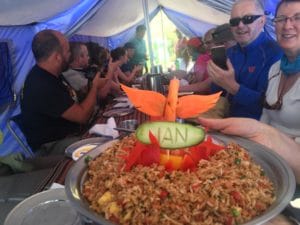
The best trekking boots for your Inca Trail Trek to Machu Picchu are showcased below. There are many different options when it comes to trekking boots, however, we are going to list five of our favorite. Of course, these are not the only options out there for suitable boots, however, these are ones that we have personal experience with. Ian Taylor has climbed Mount Everest to the top and led over 10+ trips along the Inca Trail to Machu Picchu. First of all watch our Inca Trail video before reading further. Then CONTACT US for further information. Check out our up coming trips.
There are four main factors we suggest you consider when purchasing your trekking boot. You want to make sure that you have a comfortable, waterproof boot, with both good ankle support as well as a more rigid sole. The terrain on the Inca Trail is very un-even with a LOT of steps. Having the right support in your boot will be essential for a save and successful journey.
1). La Sportiva TXS GTX
This is a new boot from La Sportiva, that has replaced our beloved Trango Trek GTX. We prefer a more rigid sole under foot and these boots do a great job. They breathe well, are lightweight and waterproof. Some of our Sherpa and Kilimanjaro guides wear these boots as well. Ian used these boots on four Kilimanjaro climbs this year along with three Everest Base Camp trips, and they are still in great condition for the same again next year. This boot would be a great option for your trek to Machu Picchu!
2). Scarpa Zodiac Plus GTX
Scarpa has come out with a new lighterweight option in the Zodiac. These boots are Gore-Tex, so a waterproof boot to keep you dry if you experience moisture on the trail. They also have good ankle support and lacing system. These boots, similar to the La Sportiva TXS, have a more rigid sole. This is ideal for the stairs you will encounter on the Inca Trail. Scarpa are always re-inventing trekking boots and if they fit your foot correctly, then they may be the right boot for you. They work great and last a long time. Also, if you decide on more challenging trails after the Inca Trail, we would also recommend these boots for a Kilimanjaro climb, Elbrus or Everest Base Camp.
3). Lowa Renegade GTX Mid
The Lowa Renegade GTX Mid boot has been around for a long time and worn by many trekkers around the world! These are a perfect boot for the Inca Trail. They are waterproof, have good ankle support, and also have a semi-rigid sole. The grip of these boots and the more rigid sole is ideal for the many stairs on the Inca Trail. The negative of these boots is that they do have a lot of stitching on them, making them more susceptible to wearing out faster than other options. However, if you treat this boot well, you could wear this option for a trek to Annapurna Base Camp as well!
4). Merrell Moab Mid 2 Waterproof
The Merrell Moab Mid 2 Waterproof Trekking Boot has been around for years and there is a good reason for that, they are a great boot! These boots boast a waterproof membrane, good ankle support, comfortable and sturdy fit. The Merrell boot may be the option for you if you have a slightly wider foot or need more room in your toe box. This boot is a reliable and durable option that will be ideal for your Inca Trail trek! We would also recommend this boot for Kilimanjaro, Annapurna Base Camp or Everest Base Camp.
5). Salewa Mountain Trainer Mid GTX
Salewa has been coming out with a lot of new and very high quality boots over the past few years. While we have not personally worn this boot yet, however, we do have a lot of clients wearing these boots on the Inca Trail. We have had very good feedback on this option! They have Gore-Tex in the boot, so they are waterproof and also have a good amount of ankle support. This lightweight, but durable boot would be a great option for your trek to Macchu Picchu.
The Best Trekking Boots for your Inca Trail Trek to Machu Picchu
All of the boots that we have mentioned above would suit for a wide range of trips! We do not want you to have to purchase one boot for one trip, so make sure you have an idea of what your trekking goals are for the future when purchasing your boots. All of these boots also come in Men’s or Women’s styles. Therefore, they should work for anyone coming on one of our Inca Trail treks!
For more information on our Inca Trail treks to Machu Picchu, GET IN TOUCH today! Read some REVIEWS.
FAQ
Trekking the Inca Trail is an incredible journey to reach the city of Machu Picchu. The trek can be done a number of ways and over number of days! Our favorite itinerary is our Classic 5 Day trek to Machu Picchu. We also have the Traditional 4 Day trek as well as a 6 Day Salkantay trek to Machu Picchu. If you have a group of four or more people, we can also cater to any itinerary you choose! GET IN TOUCH today for more information on any of our Inca Trail trips.
The additional expenses you will incur on the Inca Trail will depend on a number of factors. It will vary greatly on your itinerary, inclusions and exclusions in your specific trip. However, for our Ian Taylor Trekking trips, these are some additional expenses you may incur while in Cusco and on your Inca Trail Trek to Machu Picchu.
Additional Expenses
Visa Entry to Peru: NONE
Meals and water in Cusco/ Aguas Calientes: $100 – $200 Depending on restaurants
Tips given at the end of the trek: $150 Recommended for 4 or 5 day treks
Water on the trail: $20 If you choose to purchase this – not necessary however
Internet: NONE (Not Available)
Battery Charging: NONE (Not Available)
Boiled water for your hot water bottle: No charge for this
Souvenirs: At your own discretion
Specialty drinks along the trail: $2 to $5 – not necessary however
Water on the Inca Trail
If you are on an Inca Trail trek with Ian Taylor Trekking, you will not have to purchase any water during the trek. We recommend that you have water purification tablets with you on the trek to purify all water you drink. In the mornings, at lunch and in the evening, our staff will be able to fill your bottles or water bladders. Each time you are given cold water, however, you will need to treat that water with your purification tablets. We recommend that you are drinking 4 – 5 liters of water a day on the trail. There are also a couple of places that you can purchase water or soft drinks from people on the trail, if you choose. We do remind our clients to LEAVE NO TRACE on the Inca Trail and we do not recommend purchasing plastic bottles that likely will not be recycled.
Cusco
Cusco is a beautiful and historic city that is filled with different things to do! From the museums, historic sites, markets and shops, to the restaurants and bars, there is plenty to see and do in this wonderful city. Likewise, there is a wide range of restaurants you can choose to eat at. All of the Ian Taylor Trekking trips include three nights in a 4 start hotel in Cusco. These nights are all on a bed and breakfast basis. Therefore, you will have some extra meals to purchase on your own in Cusco. Eating in Cusco will be a highlight of your trip! It is a wonderful culinary city with a range of options for all budgets. You can enjoy small, local eateries for less than $5 a meal or you can eat at one of the delicious five star restaurants for $30 a meal!
Aguas Calientes
If you are on one of our Classic 5 Day Inca Trail trips to Machu Picchu, then you will be spending one night in a hotel in Aguas Calientes. This very unique and beautiful town will provide you with a hot shower, bed to sleep in and fun evening on the town. We provide the evening meal for our teams in Aguas Calientes, however you may also choose to buy other items in town. There is a wonderful market that you may visit with local artisans selling their goods. There are also bars, restaurants, shops and galleries through the town that you also will have an option to purchase things at. How much you spend here will depend on your personal choices!
Get in Touch for More Information
We have a wide range of trips on the Inca Trail yearly. Check out our UPCOMING TRIPS and read some REVIEWS from our trips. Then GET IN TOUCH and let us know if you need further information.
What are the best months to trek the Inca Trail to Machu Picchu? Technically, you can trek the famous and Traditional Inca Trail to Machu Picchu in any month. However, some months have more rain than others and some months have more bugs than others. Below, we will outline what we think the best months are to trek on the Inca Trail. Watch our Machu Picchu trekking video, then CONTACT US for further information.
The Seven Best Months to Trek the Inca Trail
Honestly, there really are seven best months to trek the Inca Trail to Machu Picchu. These months are from April through October. The two warmer months are going to be April and October. We have been leading treks on the Inca Trail for over ten years, and our favorite months are probably May and June. There are many festivals in the month of June, which makes it a lively place to be in Cusco! June, July, August and September are all right in the middle of Peru’s winter, which is the best time to trek. If you go in the warmer months, then you will have a lot of bugs to deal with, and that can be very annoying. Check out our TOP 10 TIPS.
The Five Best Months to Trek the Inca Trail
If we had to break down to only five months to trek to Machu Picchu, we would say the best options are May, June, July, August and September. It is not that you can not trek outside of these months, however, these five months are generally the best! You do have to be ready for precipitation at any months of the year on the Inca Trail, however, these winter months generally have the least amount of rainfall. Make sure you are doing the right preparation for your trek. Follow our TRAINING ADVICE for your Inca Trail Trek.
The Three Best Months to Trek the Inca Trail
In our opinion, the best three months to trek to Machu Picchu are June, July and August. These would also be the busiest times to be in the region as it falls in line with summer vacation for people living in the Northern Hemisphere. The weather is very steady during these three months and while you can always count on a bit of rain, generally the skies are clear! We have our own full time staff member on the ground in Cusco and we only run quality treks to Machu Picchu. Read Some REVIEWS and check out our UPCOMING TREKS.
The Best Month for Trekking to Machu Picchu
Our favorite month to trek the famous Inca Trail to Machu Picchu is June. It is a little colder than other months but generally with less bugs. As you can tell, we are not big fans of mosquitoes and bugs on the trail! The temperatures in June are generally cooler, however it does not vary greatly in the region. Usually, by 10am, the temperature is around 15c/ 60f, but the evenings and mornings are generally cooler!
The Best Inca Trail Itinerary
The 5 day classic inca trail trek, is by far the best way to experience the famous Inca Trail to Machu Picchu. If you would like to join one of our treks along the Inca trail to Machu Picchu, then get in touch with us. CLICK HERE for our 5 day trekking page. CLICK HERE for our 6 day Salkantay trek to Machu picchu and check out our REVIEWS.
The warmer months on the Inca Trail to Machu Picchu are April May, August, September and October. The colder months are going to be May, June and July. These three months are a little colder during the night, but these are the drier months which is appealing to most people.
Booking your Inca Trail Trip to Machu Picchu
There are hundreds of Inca Trails across the Incan Empire. However, the famous Inca Trail to Machu Picchu is part of the Machu Picchu National Park system. The Inca Trail and region are protected areas, managed by The Peru National Institute of Natural Resources. In order to be on the official Inca Trail to Machu Picchu, you need a permit to trek in this region and those can be difficult to get!
Strict Permitting on the Inca Trail
The government has very strict permitting rules on the Inca Trail, which is great. It keeps the trail very well regulated. Therefore the upkeep of the region, sites and Machu picchu are now better protected. Before the early 2000’s, there were no regulations safekeeping the Inca Trail. This meant that over 1,000 people per day were attempting to trek this famous trail, creating a wide range of problems. You can image the toilet situation on the trail. The Peruvian government decided to step in and make a few changes. A plan was implemented to protect the future of this UNESCO World Heritage-listed site. Read some REVIEWS from our trips.
Permits are Limited and Demand is High
There government has implemented a very strict limit on daily Inca Trail access. The permits only allow for 500 people per day to start the trail. This is roughly made up of 200 tourists and 300 porters, guides and support staff. There’s also a limit to the number of visitors allowed to enter the site of Machu Picchu – capped at 2500 people per day. With limited availability on the Inca Trail, it helps to start planning your trip well in advance to ensure you can obtain a permit in time to get a space on the trek. Permits and fees on the Inca Trail are non-transferable and they are non-refundable.Therefore deposits paid for the Inca trail are non-refundable. Check out our most important pages.
How do you Book a Permit for the Inca Trail
We make it easy for you! Our team manages all aspects of your Inca Trail trek. Our Head Guide will take care of obtaining your Inca Trail permit once you’ve booked your trip. We manage the crew, permits, food, tents, transfers, hotels and tours for you.CONTACT US for further information. We are happy to chat with you about this process.
When Should you Visit The Famous Trail
The peak season for trekking the Inca Trail is May, June, July and August. Currently permits open up for sale on the 1st October, the year before. So if you are looking to book in June, you need to be booking with us in October the year before to guarantee your space. Some companies block book dates early so this make it really difficult to secure one of the 200 spaces for any given day in the peak trekking season.
Book Early
We have been leading treks on the Inca Trail to Machu Picchu for over 15 years, and as a result, we have developed the best itineraries and service. This is a very special route and you do not want to miss out. We have our own full time staff member on the ground in Cusco, managing all aspects of the trip. Once you are about to enter the gate to the Inca Trail, your permit will be handed to you. You present the permit along with your passport to the National Park representative. Once you cross the bridge you are walking on the famous trail to Machu Picchu. Firstly, start looking at dates a year out. Secondly, think about booking six months in advance to guarantee your space. Finally, pick the 5 day Classic itinerary for the best possible experience.
No Permits Left
Don’t worry. We can still make your dream of hiking the Andes and visiting Machu Picchu a reality. There are lesser known trails to reach Machu Picchu that are also options. We can also tailor a trek encompassing cultural experiences off the beaten path for you. Some of these other trails do not require permits. This makes it possible to make a last-minute decision to go trekking in Peru.
Would you Rather Catch the Train to Machu Picchu?
We hope you like our Inca Trail trekking video below. If you have read all our information on trekking to Machu Picchu and feel it’s not for you, we have other options. That’s fine, you can still visit Machu Picchu and take the bus, train and bus option. If you would like further information on this CONTACT US.
Ready to experience Machu Picchu for yourself? Ian Taylor Trekking have you covered on our small group adventures in Peru.
We only serve quality food on Inca Trail treks to Machu Picchu. You can either fuel your your body with premium or regular fuel and we chose to offer premium! To give yourself the best chance at success you need the right itinerary, acclimatization, staff, support, safety. Likewise, you need the best food available to fuel your body each day. Our trips offer a wide range of fruit, vegetables, meat and grains to give your body what it needs when exercising!
The Best Experience When Reaching Your Goal
We have been running trips along the Inca trail now for over 12 years. In addition we have helped over 1,000 people reach the majestic city of Machu Picchu. You can choose from many different itineraries, including our 4 day, 5 day and 6 day treks. We pride ourselves on helping people get the right training and preparation information prior to their trek. Our team can give you training advice, information on daily distancesand we are always available to help you get accurate information. If you want to be safe and successful, then let us answer all your questions on this very special adventure. Read some REVIEWS from our trips.
High Quality and Nutritious Meals
We pride ourselves in offering a wide range of quality food at each meal. On the trail, you will be served three course meals, three times a day, including nothing but the best available. Making sure that you have the right quality, nutritious and fresh meals throughout the entire trek is very important to us.
Fresh, Nutritious and Varied Meals
Likewise, our team can accommodate your food sensitivities as well. If you are gluten free, vegetarian or follow other special diets, then we can make sure you have the food you need. We have developed the right menu over the years to give you quality throughout. READ SOME REVIEWS from people who have been on our Inca Trail trips to Machu Picchu.
Sample Menu for the Inca Trail
Day 1
Breakfast: This will be served in the hotel before you leave
Lunch: Soup, Chicken, potato, Vegetables and pies
Afternoon Tea: Tea, Coffee Hot Chocolate or Milo, served with Cake, popcorn, local nuts
Dinner: Soup, Fresh Sea Fish with a choice of Tartar or Tomato Sauce, Parsley Potatoes, Sauteed Beans, Avocado Salad, Fresh Fruit. We also have Tea and Coffee.
Day 2
Breakfast: Cereal with Raisins, eggs, Honey, Jam with pancakes and fruit. We also serve Tea, Coffee Hot Chocolate or Milo
Lunch: Soup served with Garlic Bread. Rice, quinoa, oies, chicken, beef and vegetables, french fries, salad Fresh Fruit. We also serve Fruit Juice, Tea, Coffee Hot Chocolate or Milo
Afternoon Tea: Tea, Coffee Hot Chocolate or Milo Served with Biscuits and Popcorn
Dinner: Soup served with White or Brown Bread, Chicken, vegetable patty, served with Steamed Rice, mixed vegetables and regular vegetables. We also have Tea, Coffee Hot Chocolate or Milo and cake.
Day 3
Breakfast: Fruit, local Porridge, cereal, Eggs served with bread and choice of Honey, Jam, Marmalade and Peanut Butter. Also, Tea, Coffee Hot Chocolate or Milo will be served.
Lunch: Soup served with White or Brown Bread. Mixed vegetable rice with Salad. A range of vegetable pies, eggs, vegetables and cake. Fruit Juice. Tea, Coffee Hot Chocolate or Milo
Afternoon Tea: Tea, Coffee Hot Chocolate or Milo, Served with Biscuits and Cake
Dinner: Sweet Corn & Sweet Potato Soup served with White or Brown Bread, Beef Goulash with Vegetables, Served with Steamed Rice, Banana Fritters and Honey. We also have Tea, Coffee Hot Chocolate or Milo.
Day 4
Breakfast: You will be served a full breakfast high above Machu Picchu at Phuyupatamarca 3,700m/ 12,136 feet. This is one of our favorite campsites on the whole of the Inca Trail. You will sit high above Machu Picchu mountain with stunning views of the surrounding mountains.
Lunch: We include a quality lunch for you in Winaywayna before the magical hike to the sungate and down into Machu Picchu.
Get in Touch Today
We have 2 – 4 chefs and 6 support staff working in the kitchen on our Inca Trail treks to Machu Picchu. We offer quality fresh food on all our Inca Trail treks. Read some REVIEWS from our Inca trail trips and consider us for your Inca Trail trekking adventure next year.
Remember you need to book well in advance to secure your place on the trip! If you want the best experience on the Inca Trail to Machu Picchu. Here are 20 reasons to choose Ian Taylor Trekking for your Inca Trek to Machu Picchu.
Have you signed up to a Trek on the Inca Trail? Whenever you travel to a foreign country, you should consider what vaccines you need to get. Firstly, you should consult your doctor to make sure you should be joining a team to trek on the Inca Trail to Machu Picchu. Before you join this adventure, you need to be fit, strong and in good physical shape. Even though the Inca Trail is a trek accessible to most people, you will need to put in specific training and preparations to make the trip a safe and successful journey. If you are concerned about your health and fitness you need to speak with your doctor and then Contact Us and we can help you develop a training plan that it critical for success.
People are always asking us what vaccinations are needed for an Inca trail trek to Machu Picchu. While there are no legally required vaccinations for entry or exit from Peru, there are however, some recommended ones. We suggest that you keep up to date with the current vaccine list through the CDC or your local Travel Medical Center. The recommended vaccines will also depend on when you where else you will be traveling when you visit Peru as there are different recommendations for different regions.
Recommended Vaccines for Peru
These are the current recommended vaccines for a Machu Picchu trek in Peru:
1). Tetanus
2). Yellow Fever
3). Hepatitus A
4). Hepatitus B
5). Typhoid
6). Poliomyelitis
7). Rabies
8). Tuberculosis
9). Malaria
Insect Bites
Bugs like mosquitoes, ticks and fleas can spread numerous diseases in Peru. Many of these can not be prevented from medication or vaccines, however you can protect yourself from bug bites in other ways. Here are a few ways to protect yourself from bug bites:
1). Wear long pants, shirts and a hat, in order to limit your amount of exposed skin.
2). Use appropriate insect repellent. We recommend one with DEET in it.
3). Use permethrin-treated clothing and gear (such as boots, pants, socks, and tents). However, do not use permethrin directly on skin.
All You Need to Know about the Inca Trail
For more information on everything you need to know about visiting Machu Picchu, then CLICK HERE. We are your trekking experts and have full time staff on the ground in Peru. Therefore, we are your number one resource for the trek and if you sign up to one of our trips, we will be available to assist with all your questions to make sure you come fully prepared for the journey. Our team on the ground have expert knowledge on the trail and the Inca People to make sure that you have a insightful and wonderful experience. Feel free to read some reviews from our trips and get in touch for further information. If you want a great experience on the Inca Trail, then contact us today!
Ready to go?
Our Ausangate Circuit Trek will give you the best chance of success. Does this information excite you to take the next step towards achieving your goals of trekking more of Peru. If so, get in touch today.
Our team in the US and Peru, pride ourselves in making sure that our clients have every opportunity to succeed on the mountains, including professional training advice, gear lists and video links on how to pack your bag, and much more.
We are always available 5 days a week to answer any questions you may have by email, phone or skype, so contact us today!



